50 Years of Huron Pines
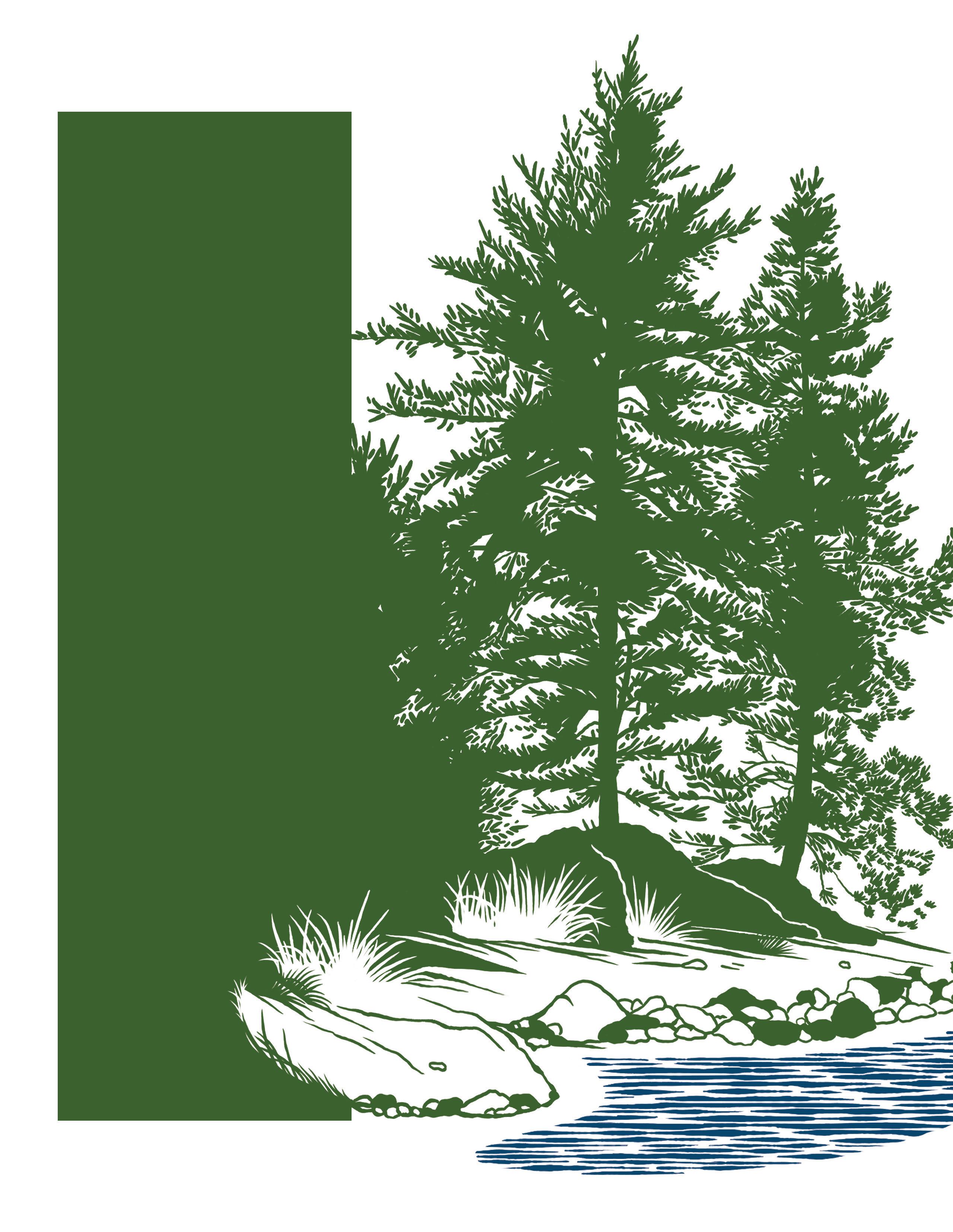
Annual Report 2022
Healthy Water. Protected Places. Vibrant Communities.
Board of Directors Staff
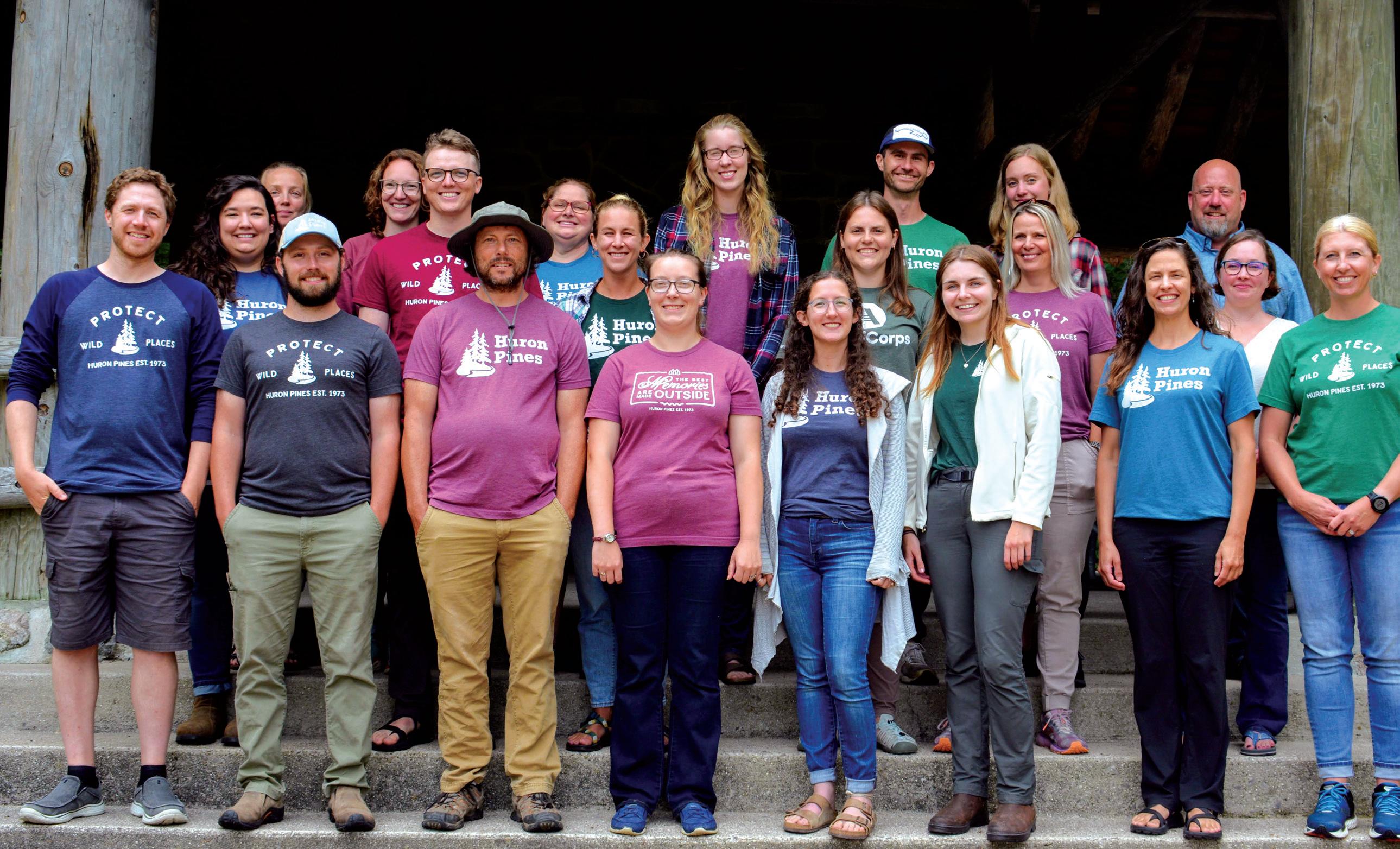
Greg Bator Chair
Jennifer Hill Vice Chair
Meaghan Gass Secretary
Chip Erwin Treasurer
Ned Caveney
Alex Code
Rich Castle
Joe Jarecki
Kim Margherio
Dan O’Connor
Tony Pitts
Jerry Rucker
Donette Spiekerman
Brad Jensen Executive Director
Lisha Ramsdell Associate Director
Shelby Bauer Stewardship Program Coordinator
Julia Butch Land Protection Coordinator
Tonya Clayton Office and Data Manager
Chris Engle Communications Associate
Abigail Ertel Community Program Director
Logan Hawley Coastal Restoration Team Lead
Amber Hubbard Coastal Stewardship Coordinator
Heather Huffstutler Development Director
Maddie Khuri
Community Education Project Manager
Paige Lackey Communications Manager
Josh Leisen Senior Project Manager
Samantha Nellis Water Program Director
Amy Nowakowski Coastal Project Manager
Nick Theisen Water Program Technician
Amanda Vanaman AmeriCorps Program Manager
Steve Woods Conservation Stewardship Director
Jennie Zoll
Finance and Administration Director
Dear friends,

I recently found a musty folder from the earliest days of Huron Pines deep in the recesses of our office. Inside was a letter from Governor Milliken, dated 1973, urging Huron Pines on as we were just getting started 50 years ago. The top projects were laid out in those old pages — protecting wildlife corridors, restoring streams, improving forest health and helping communities develop recreational opportunities.
Those remain high priorities for Huron Pines. While our organization has accomplished so much in the last 50 years, the work does not cease and the complexity of environmental challenges continues to grow. We are facing a loss of biodiversity, persistent groundwater contamination, the effects of a changing climate, and increased demands on land and water. Over the years we have grown our staff and board, built our donor base and strengthened our partner network to meet these demands and prepare for the future.
In 2023, we’re looking to become a full-time staff of 22, with a summer stewardship crew of eight. We continue to administer an AmeriCorps program with another 25 people who give a year of their lives in service of conservation. We’ve strategically chosen board members who lend their time, skills and expertise to create a successful and dynamic organization. We’ve expanded our base of generous donors engaging new individuals, foundations and corporations each year from Michigan and beyond who make this all possible. We continue to build relationships with community partners, businesses and fellow land conservation organizations through our growing land protection, stormwater management and community engagement programs.
Huron Pines’ vision is about long-term stewardship of natural resources and with that long view in mind, we continue to do work like remove dams to restore streams, protect land for sustainable management, create nature preserves, increase our community learning opportunities, re-establish native ecosystems and build our portfolio of endowment funds to help keep this work going long after we’re gone.
Having been with Huron Pines for nearly half its history, the daily reward of seeing all the preparation that staff put into their work in order for projects to come to fruition never ceases to amaze me. I get to work with some of the most talented, gritty, funny and marvelous people who are driven to protect, improve and restore all the best that Northern Michigan has to offer.
I have so much gratitude for everyone who has had an impact on Huron Pines these last 50 years and I hope you are excited to continue with us in this important land and water conservation journey. It’s a time to celebrate what’s been accomplished and also prepare for the next generation of environmental challenges.
Brad Jensen Executive Director

The mission of Huron Pines is to conserve and enhance Northern Michigan’s natural resources to ensure healthy water, protected places and vibrant communities.
Conservation driven by engaged, empowered communities.
Our Mission Our Vision
Greetings,
Stepping into the Board Chair role after dedicated service from past chairs — Joe Jarecki, Jerry Rucker, and Connie Schrieber — gave me a true sense of how far the impact of Huron Pines could really reach. I saw firsthand what good ideas, secure funding and talented people can accomplish not only for Northeast Michigan but for the entire Great Lakes region.
My journey with Huron Pines began in 1995 after buying a lakefront cabin in Lewiston. A legendary conservationist, Pete Petoskey, encouraged me to attend a Huron Pines meeting in Gaylord. I was impressed that my modest contribution could be leveraged ten-fold by Huron Pines to protect and restore the woods, fields and waters that were becoming my second home.
When taking a seat on the Huron Pines Board, I realized that my time and efforts were actually leveraged 100-fold thanks to an incredibly talented staff led by a great Executive Director, Brad Jensen.
Huron Pines’ work allows brook trout the freedom to traverse cold, unimpeded streams, gives migratory birds safe stops on their way south and back north, restores habitat for native plants to blossom, and protects the solitude of woods and fields.
Your involvement with Huron Pines helps make these accomplishments possible. You’ve earned the right to share in our successes and celebrate with your neighbors and friends.
Help us celebrate our 50th anniversary and inspire others to relish Northeast Michigan’s treasures. Raise your voice for healthy water, protected places and engaged communities. Show people of the region what it’s like to be part of something larger than yourself.
We have accomplished a lot in 50 years. With your continued involvement and support, the next 50 years will be just as successful. Thank you for being a vital part of this work!
With gratitude and respect,
Gregory Bator Board Chair
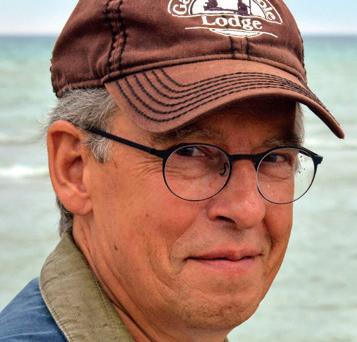

2 | Huron Pines 2022 Annual Report
A Land Protection Trifecta
Three properties encompassing more than 1,500 acres of forests and wetlands are protected forever.
New Partnership Builds on Warbler Success for Landscape-Scale Restoration
Huron Pines & partners apply proven methods and new strategies in restoring Michigan’s jack pine ecosystems.
Timberland Restored
A river flows free after 70 years with the removal of a private dam at a family hunting and fishing retreat.
Working Around Rare Wildlife
Water Program staff seek to protect Michigan’s most sensitive aquatic species.
Engaging Volunteers & Community Voices
Coastal communities implement stormwater solutions to protect Lake Huron.
It Takes a Village
From grassroots community science to international initiatives, our friends and partners carry our conservation goals forward.
Compelled to Serve
We celebrate 17 years of developing leaders in conservation with Huron Pines AmeriCorps.
Obtawaing Biosphere Region
The convergence of the upper Great Lakes and Michigan’s peninsulas is recognized for its ecological & cultural importance.
Financial Overview
Treasurer Chip Erwin shares a few words about organizational sustainability.
In Recognition of Service: Judy Kalmanek
A longtime advocate of Huron Pines retires after eight years with our board.
In Memoriam: Roger Frye & Connie Schrieber
Tributes to two dear friends we lost in 2022.
To celebrate how far we’ve come, we’ve included a look back at past projects that have helped shape our organization. You will find these write-ups on the right side of each page throughout the report.
3
Contents 6 14 12 20 22 24 28 8 16 10 18
1973
Huron Pines Founded
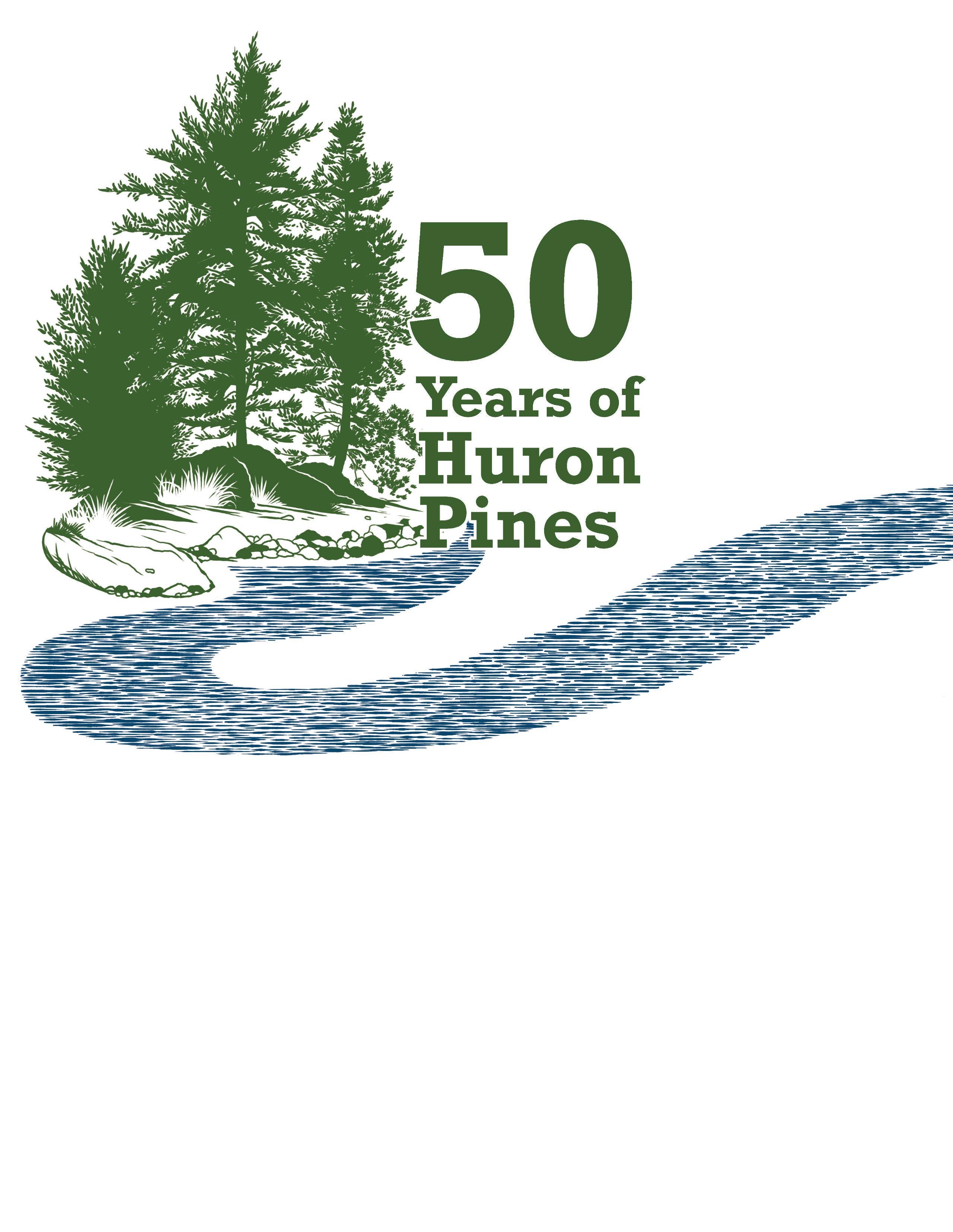
E ight Northeast Michigan counties and the United States Department of Agriculture created Huron Pines Resource Conservation & Development Project with the purpose of expanding economic opportunities for the area through the orderly conservation, improvement, development and wise use of their natural resources.
1974
State Support Approved
H uron Pines’ first strategic plan adopted and endorsed by Governor Milliken.
1986
Non-profit Status Granted
uron Pines
as a
4 | Huron Pines 2022 Annual Report
H
incorporated
501(c)(3) nonprofit in Michigan.
1998
Stream Health Prioritized
The Great Lakes Better Backroads Guidebook is published, marking the beginning of a 25-year focus on aquatic connectivity. Staff present road/ stream crossing best management practices to county road commissions around the state.
2007
Huron Pines AmeriCorps Program Launched
O ver 400 people have served as AmeriCorps members since its inception, many continuing on to fill full-time conservation positions in Michigan and the Great Lakes region.
2018
First Nature Preserve Opens to the Public
Hubbard Lake Nature Preserve opens to the public. The property, a generous gift from John and Wendy Frye, is the first preserve owned and managed by Huron Pines and marks the official launch of the Huron Pines Land Protection Program.
2008
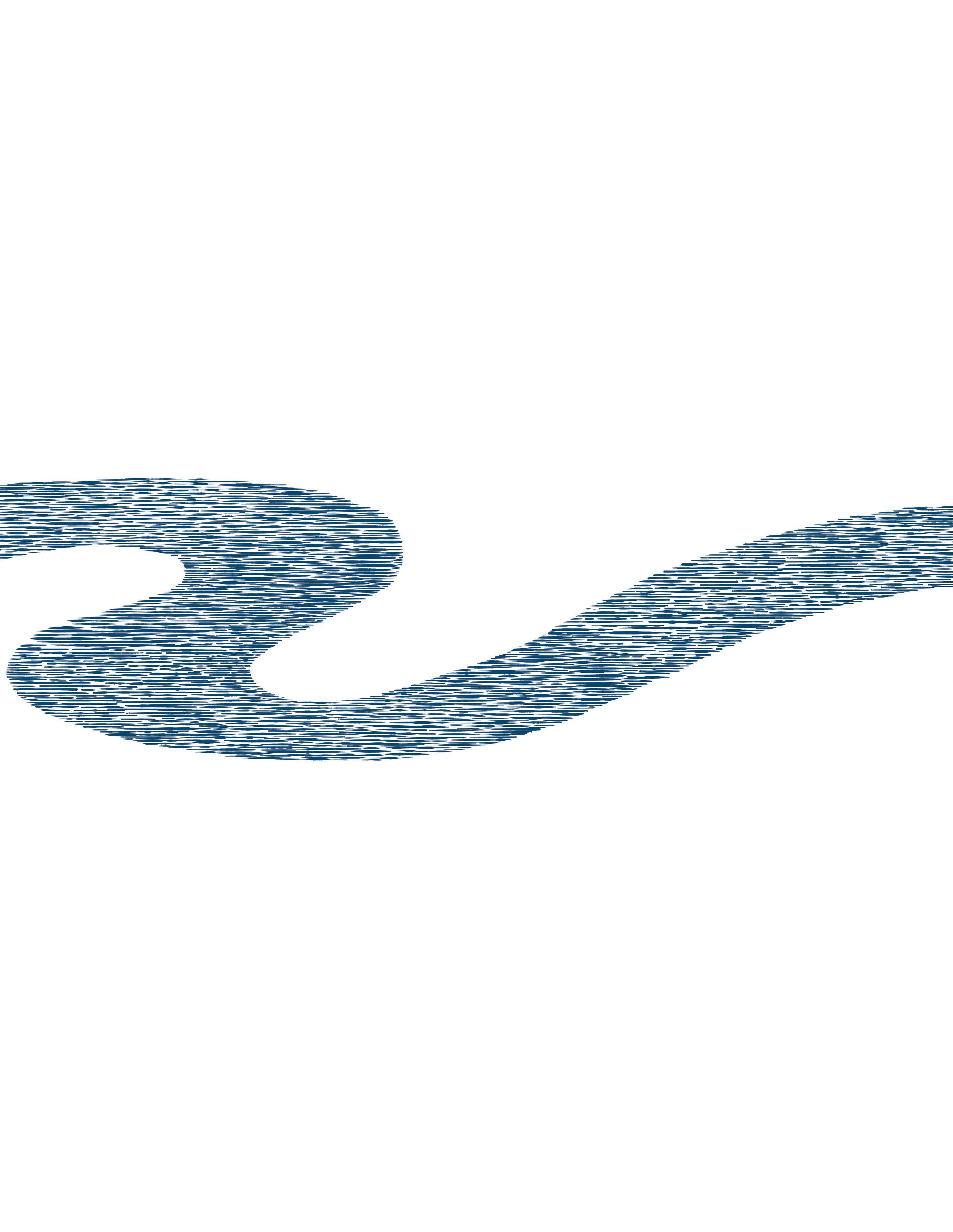
Focus on Sustainable Impact
Huron Pines prioritizes programs based on long-term impact and regional scale, and launches two new efforts that continue today: invasive species management and dam removal.
Alpena Office Established
Huron Pines opens a second office in Alpena to foster our work with communities along the Lake Huron coastline.
2020 2021
Supporting the Great Lakes Region
Huron Pines continues to focus on regional impact, building partnerships in the Eastern Upper Peninsula and inventorying 800 road/stream crossing sites as well as accelerating efforts with partners in Canada to build a strong Lake Huron Forever program.
50 Years of Huron Pines | 5
A Land Protection Trifecta
Land protection efforts at Huron Pines have continued to grow with the addition of three new Alpena-area coastal properties — North Point Peninsula, Birdsong Bay Nature Preserve and the KR Poljan Tract.
The properties were transferred to Huron Pines in December of 2022 and January of 2023. They encompass more than 1,500 acres of protected forest and wetland which strengthens our ongoing effort to protect the health of Lake Huron and steward its coastal habitats.
“Alpena’s unique coastal areas combined with rare habitats, islands, peninsulas, shipwrecks and recreational opportunities are what will define the region for generations to come,” said Huron Pines Executive Director Brad Jensen. “It’s a privilege to apply our skills and experience to the ongoing support and protection of this exceptional landscape.”
In December, The Nature Conservancy (TNC) officially transferred ownership of their properties, North Point Peninsula and Birdsong Bay Nature Preserve, to Huron Pines.
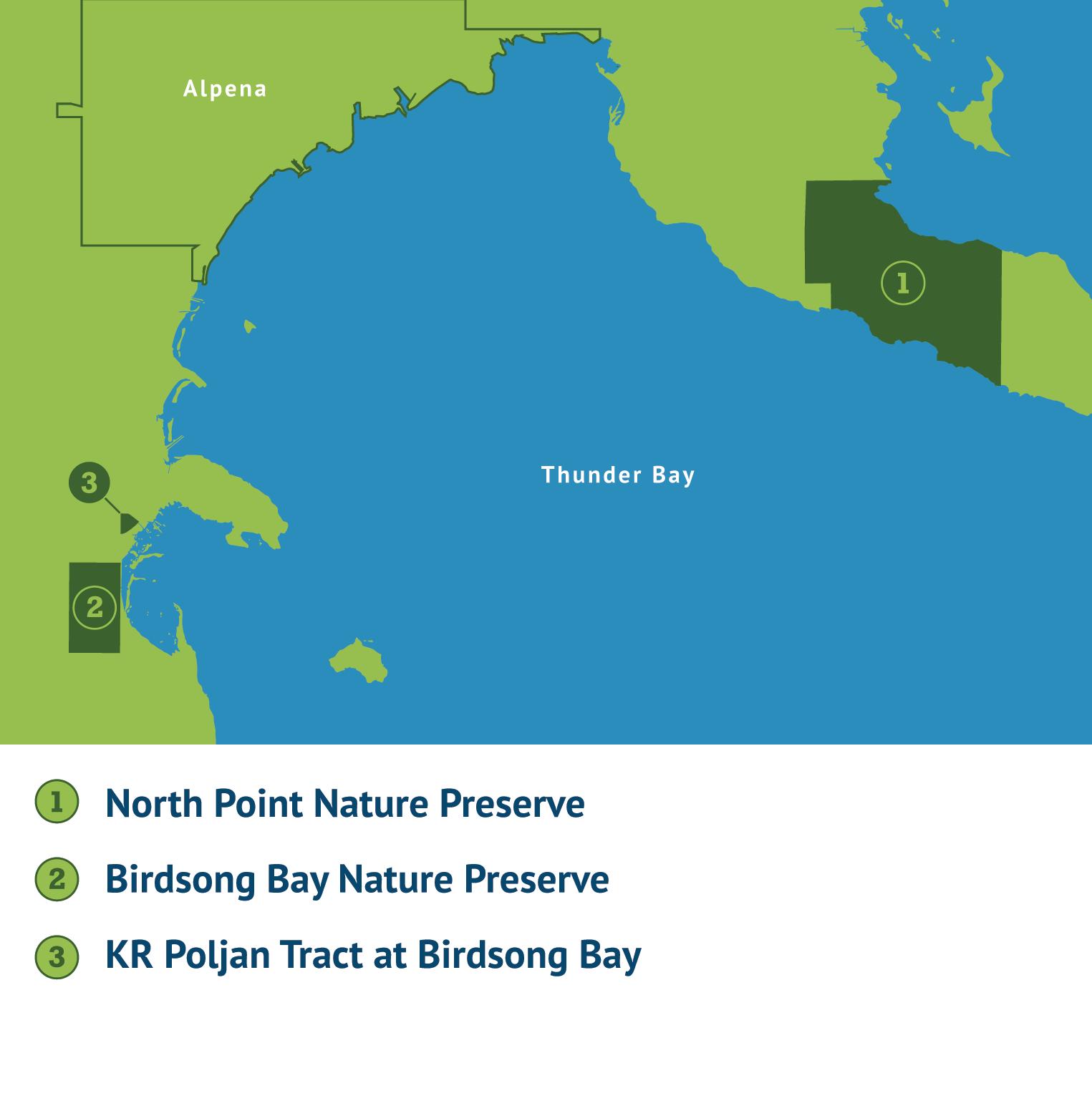
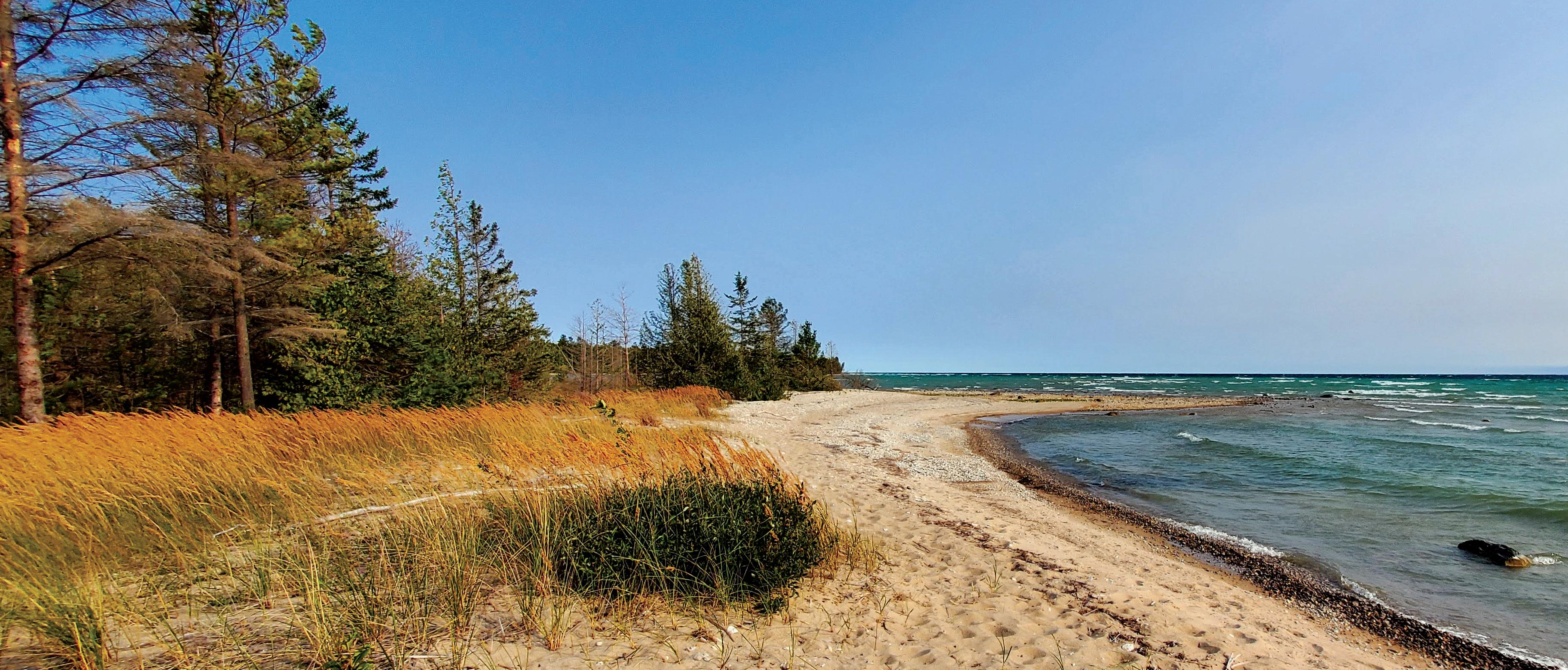
“Our partnership with Huron Pines dates back years and they have been with us, side-by-side, helping create and implement a restoration plan for North Point that benefits both people and nature,” said Helen Taylor, state director for TNC in Michigan. “North Point truly is a gem, and these lands are undoubtedly in good hands.”
North Point Nature Preserve is located in the heart of the Thunder Bay National Marine Sanctuary, the first freshwater sanctuary in the U.S. The 1,400-acre North Point Nature Preserve features 4 miles of coastline home to carnivorous plants and the endangered Hine’s emerald dragonfly. The 153-acre Birdsong Bay Nature Preserve is situated on the 45th parallel south of Alpena. The preserve includes cedar swamps and a globally rare wooded dune and swale wetland complex which support a diverse ecosystem of plants and wildlife.
“To have The Nature Conservancy and Thunder Bay National Marine Sanctuary help us protect and provide for the use and enjoyment of these places – it’s the type of partnership that makes for a strong future,” said Jensen.
A third property, the KR Poljan Tract at Birdsong Bay, was gifted to us in early January through a donation from the Richard Poljan estate. This 15-acre preserve on Partridge Point offers a panoramic view of Birdsong Bay and is frequented by shorebirds and migratory waterfowl. Richard J. Poljan, an avid outdoorsman, wanted this property protected and shared with the community.
Huron Pines has defined the area, rich with ecological, geological and cultural resources, that stretches from Cheboygan County to the Au Sable River as a Coastal Priority Zone. All three of these new preserves are within that Coastal Priority Zone and bolster our efforts to protect the land from development, prevent and remove invasive species and support native plant and wildlife.
Protecting and managing these lands comes with ongoing costs. An endowment fund has been established with the Community Foundation for Northeast Michigan to support the current and long term conservation of lands within the Coastal Priority Zone. Contributions to the Huron Conservation & Stewardship Fund can be made at cfnem.org.
Top: A shoreline view of North Point Nature Preserve
6 | Huron Pines 2022 Annual Report
Forever Home
Lake Huron Coastal Preserve in the hands of Alabaster Township
In 2020, Huron Pines set into motion a plan to see 145 acres, including 4,000 feet of Lake Huron coastline, protected forever by the Alabaster Township community. In December of 2022, that plan came to fruition as Huron Pines officially transferred ownership of the Lake Huron Coastal Preserve to Alabaster Township.

Huron Pines and Alabaster Township worked together every step of the way, from establishing a Parks and Recreation Committee to launching a successful fundraising campaign and submitting and receiving a Michigan Natural Resources Trust Fund grant.
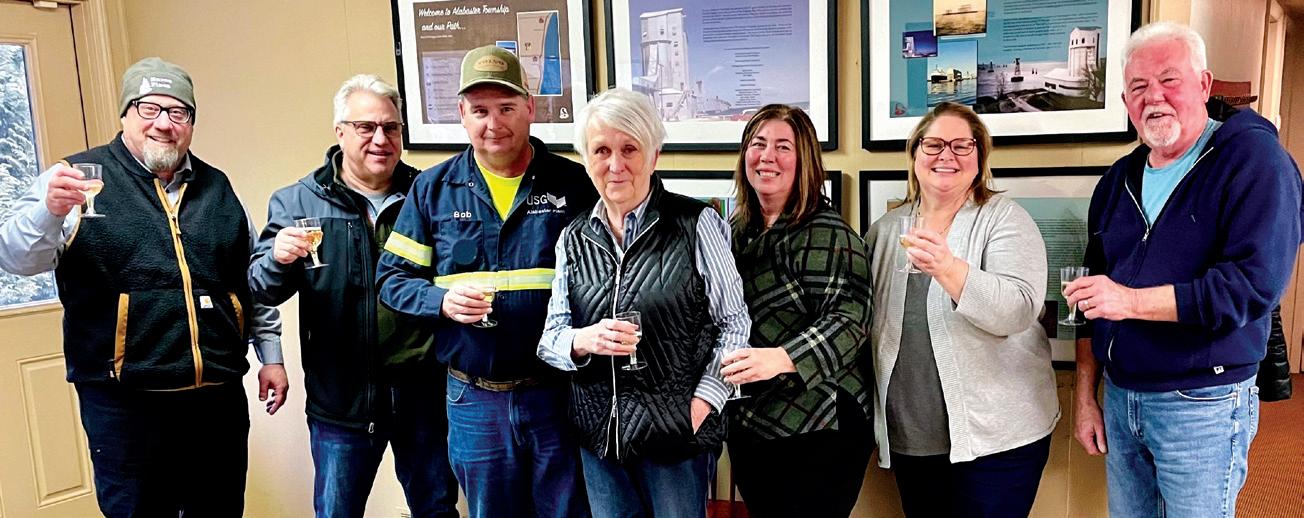


This project is a shining example of our vision of conservation driven by engaged, empowered communities. We hope it inspires others to prioritize natural spaces as an essential part of a thriving community.
With deep gratitude, we thank the coastal residents, local leaders, supporters and funders who made Lake Huron Coastal Preserve possible.
Hubbard Lake Nature Preserve Leads the Way
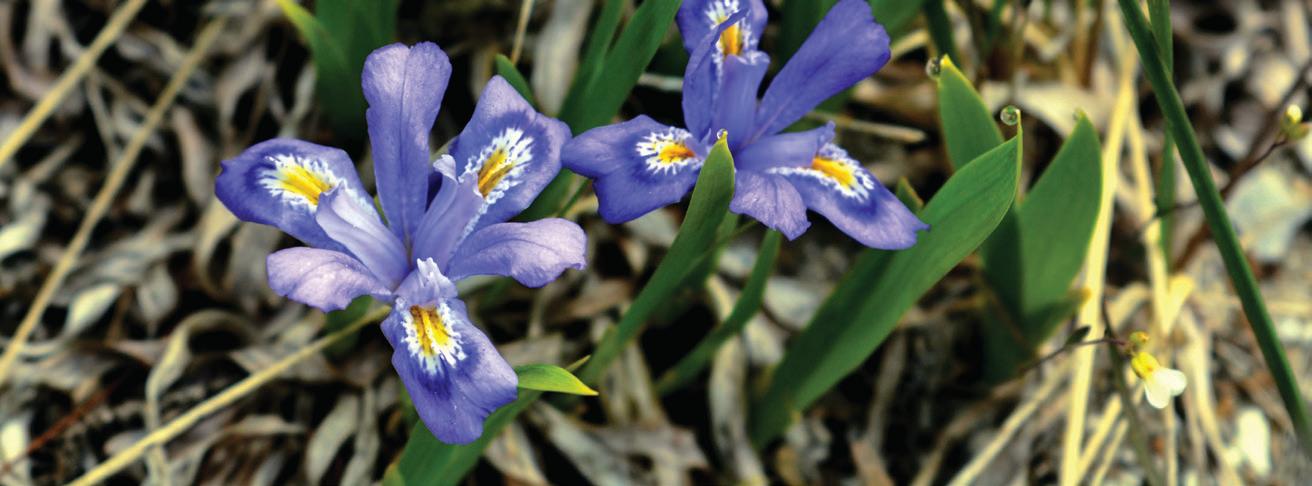
In 2018, Huron Pines celebrated the grand opening of Hubbard Lake Nature Preserve, our organization’s first public preserve. Since then, the 80-acre property has welcomed neighbors, visitors, partner organizations and student groups, and is used as a facility for training and team building for our seasonal restoration crew.
This property came to Huron Pines as a generous gift from John and Wendy Frye. We are honored to be the organization entrusted with the important task of preserving and stewarding this property. Through our continued stewardship, visitors can enjoy a forested landscape — for peace and relaxation, research and education — forever.
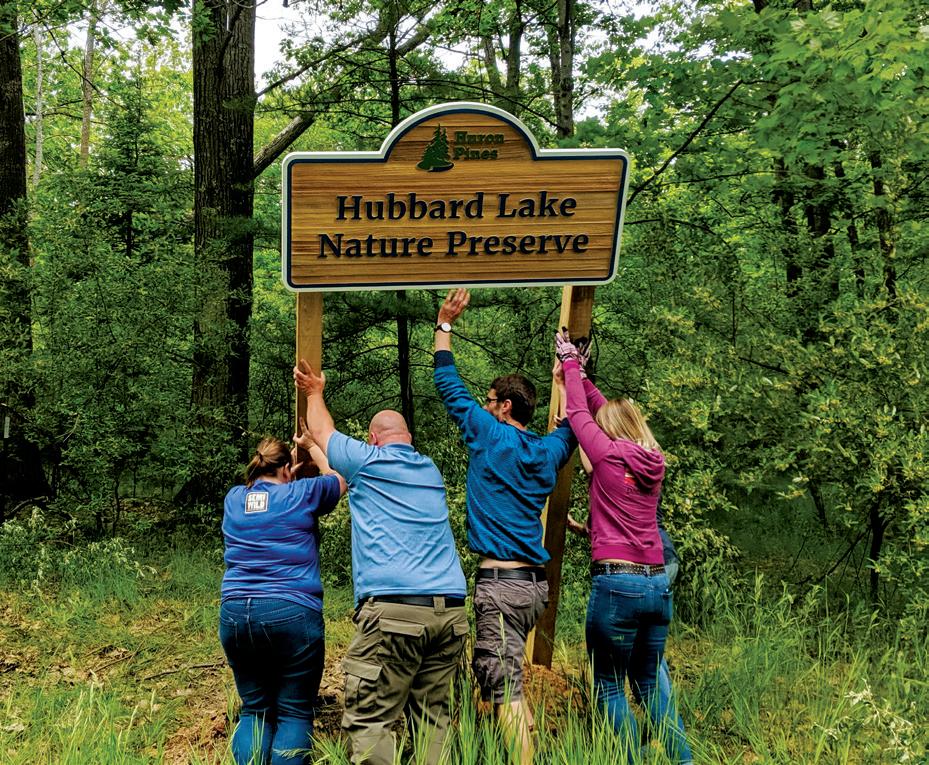 Raising the sign at Hubbard Lake Nature Preserve in 2018
Alcona students install native plants at the preserve in 2021
Dwarf lake iris, Michigan’s state wildflower, at North Point Peninsula
An aerial view of Birdsong Bay Nature Preserve
Raising the sign at Hubbard Lake Nature Preserve in 2018
Alcona students install native plants at the preserve in 2021
Dwarf lake iris, Michigan’s state wildflower, at North Point Peninsula
An aerial view of Birdsong Bay Nature Preserve
A Land Protection Trifecta | 7
Representatives of Huron Pines, Alabaster Township and US Gypsum celebrate the transfer of Lake Huron Coastal Preserve with a champagne toast.
New Partnership Builds on Warbler Success for Landscape-Scale Restoration
The work of many saved one bird from the brink of extinction. Can the same be done for an entire ecosystem?
At the heart of Oscoda County, amid the remnants of an ancient glacial outwash plain, exists one of the most species-rich places in Northern Michigan.
Welcome to the Mio Plateau, a region defined by jack pine forests, rolling grasslands and wildlife found nowhere else on Earth. These pine barrens had been the dominant natural community across large parts of the Northern Lower Peninsula after the last ice age ended some 11,000 years ago, inhabited by species adapted to this arid landscape where water is scarce and fire was frequent.

In more recent times, human activities like land development, the suppression of wildfire and the introduction of invasive species shrank and fragmented this landscape to a vestige of its former self. As habitats disappeared, species followed suit, among them a famed blue and yellow bird whose plight sparked a decades-long endeavor to save it from extinction.
The recovery of the Kirtland’s warbler is a success story shared by many natural resource organizations, including Huron Pines, who worked diligently to restore the bird’s nesting habitat of young jack pines across swaths of Oscoda and neighboring counties. The warbler came off the Endangered Species List in 2021 and Huron Pines and its allies are joining forces again, this time for the benefit of the broader landscape.
“The Kirtland’s warbler is just one resident of the larger jack pine ecosystem,” said Steve Woods, Conservation Stewardship Director for Huron Pines. “Because it was once so critically imperiled, it made sense to focus
on it first. Now that it has been delisted, we’re shifting to a more holistic approach on behalf of many other species, some of which are threatened.”
Working Together to Benefit All Species
To restore this ecosystem, Huron Pines is leading the development of the Northern Pine Plains Partnership with state and federal agencies whose combined land ownership covers a significant portion of the Mio Plateau. Through this partnership, Huron Pines is working with resource professionals at U.S. Fish & Wildlife Service, U.S. Forest Service, Michigan Department of Natural Resources and Camp Grayling on coordinating habitat restoration efforts across the lands these agencies own and manage. Other partners include American Bird Conservancy, HeadWaters Land Conservancy and the Kirtland’s Warbler Conservation Team. This partnership is an opportunity to experiment with using a variety of techniques, including prescribed fire, to promote species diversity, suppress invasive plants and improve the outcomes for all species which reside there. Additionally, Huron Pines’ budding Native Seed Program, which utilizes locally collected seed to propagate native grasses and wildflowers, will also play a role in this work (see next page).
“The great thing about this partnership is that we have biologists, ecologists, experts in prescribed fire and other resource professionals all at the table,“ Woods said. “Through cohesive co-management, there’s the potential to influence thousands of acres and have a significant, positive impact on the landscape.”
Lasting Partnerships Support a Shared Landscape
Huron Pines and its partners will work to rebuild the ecosystem by testing new techniques, reintroducing native plants and restoring natural diversity to the ecosystem. Standing to benefit are some incredibly rare and protected species like the massasauga rattlesnake, dusted skipper butterfly and the secretive locust, a short-winged grasshopper found only in six Michigan counties. Threatened plant species like Hill’s thistle and pale agoseris grow here among vast purple seas of native blazing star wildflowers buzzing with pollinating insects.
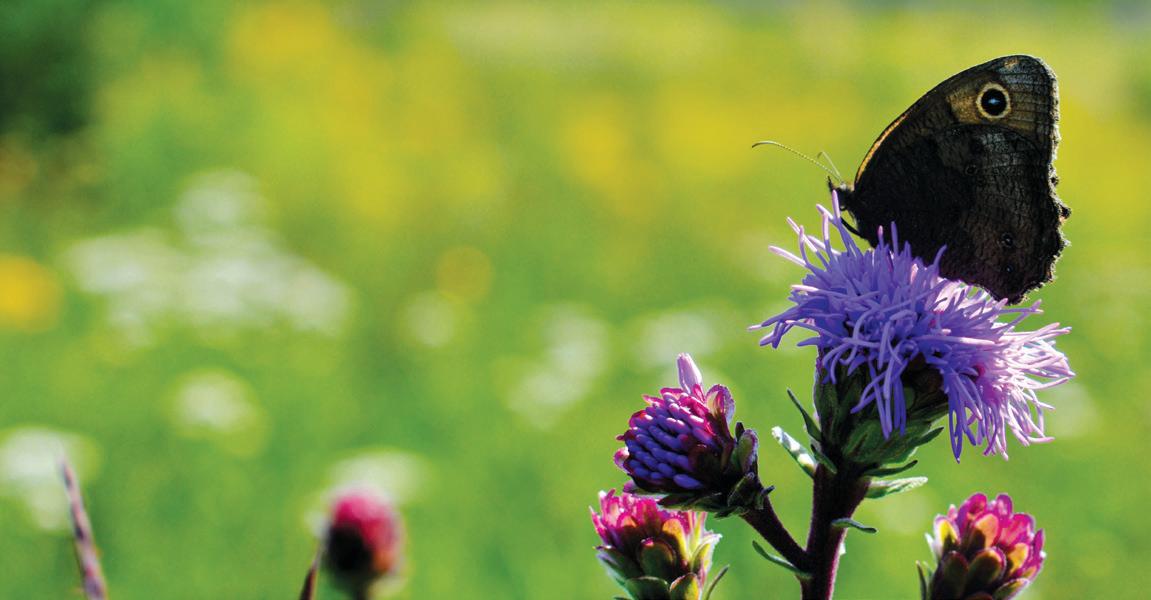
8 | Huron Pines 2022 Annual Report
Top: A panoramic view of the Mio Plateau, one of Michigan’s most intact pine barren landscapes rich with native grasses, wildflowers and wildlife.
“The warbler came off the Endangered Species List in 2021 and Huron Pines and its allies are joining forces again, this time for the benefit of the broader landscape.”
All these species have historically shared the landscape with Kirtland’s warbler and help define the jack pine ecosystem. They also suffered the consequences of habitat loss but did not necessarily benefit from the restoration efforts which were focused solely on the songbird. Lessons learned from those efforts, and the partnerships formed along the way, will continue to play a significant role in restoring the health of the ecosystem as a whole.
Abigail Ertel is Community Program Director for Huron Pines. She helped lead the Kirtland’s Warbler Initiative in 2012 as a way to transition partners from population recovery efforts to those promoting the bird’s sustainability long term. She sees parallels between the success of that initiative, which facilitated the 2021 delisting, and the great potential of the Northern Pine Plains Partnership.
“At that time, Huron Pines brought experts to the table in order to solve a serious problem,” Ertel said. “We helped build relationships between partners and lifted them up to meet complex challenges together. I think the Northern Pine Plains Partnership can inspire connections that go beyond just a single species and foster an appreciation for the landscape as a whole. That’s what I’m looking forward to seeing happen.”
The Northern Pine Plains Partnership is supported in part by the Great Lakes Restoration Initiative, the U.S. Fish & Wildlife Service and the Michigan Department of Natural Resources’ Wildlife Habitat Grant Program.
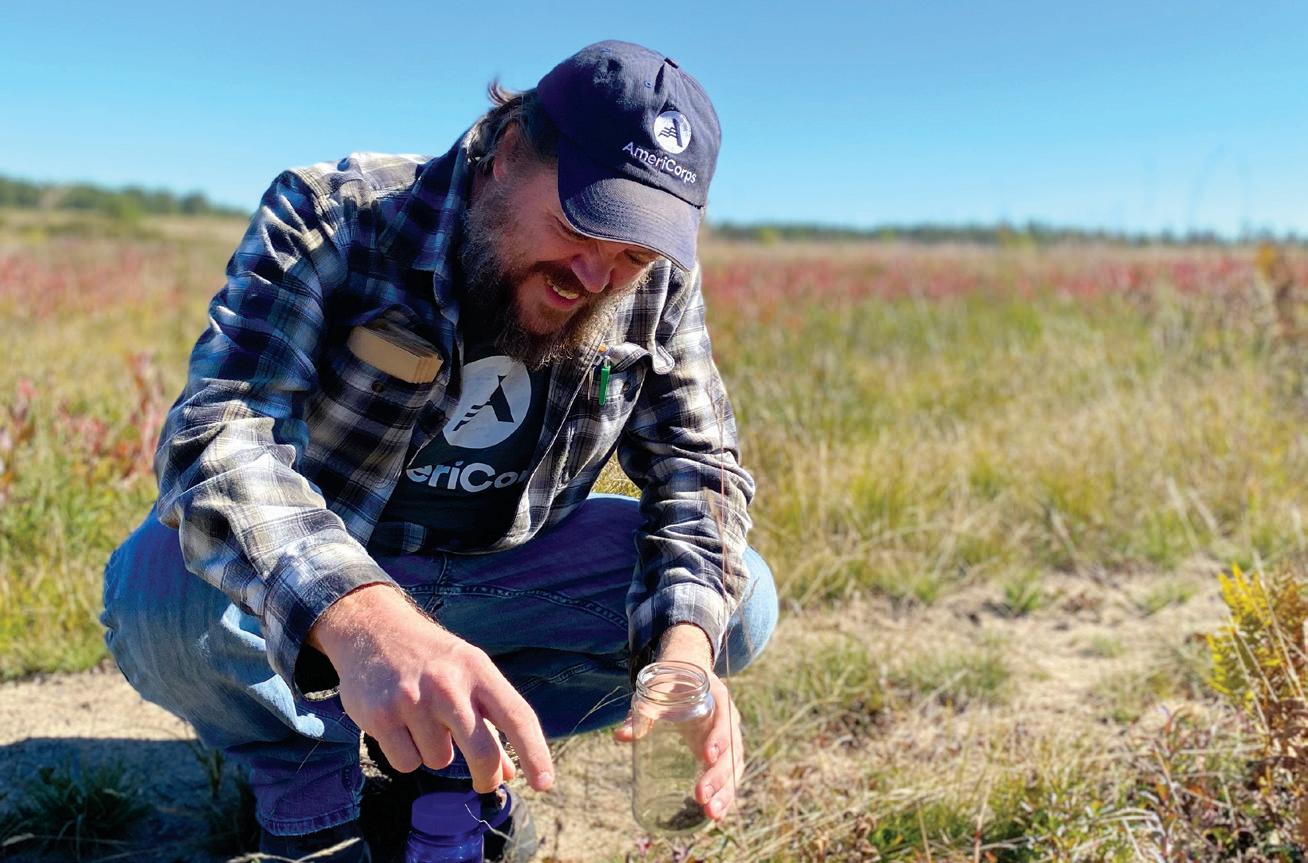
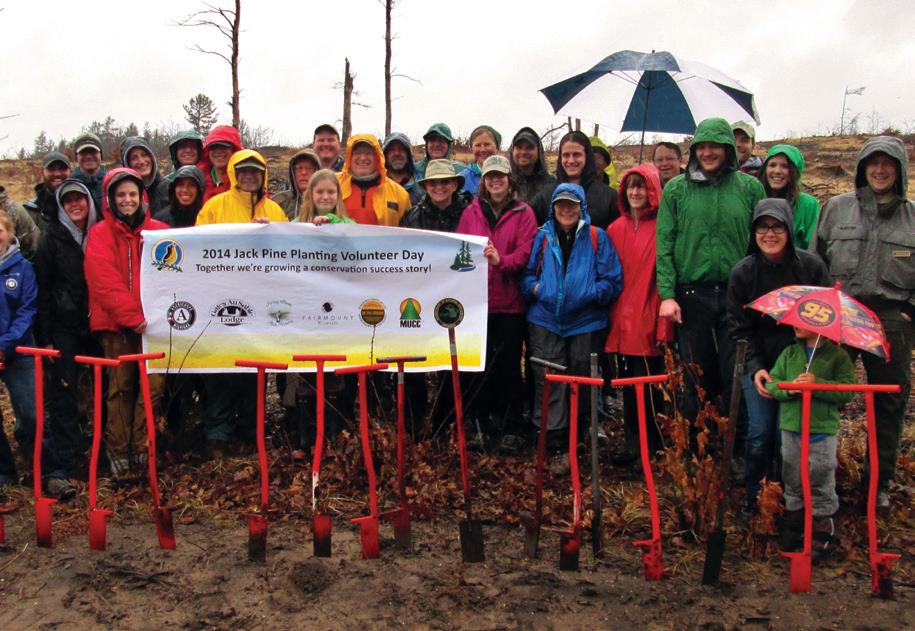

Learning and Collecting on Rare Landscapes
Huron Pines AmeriCorps members spent a sunny September day with the Huron Pines Stewardship Team exploring Northern Michigan’s jack pine barrens and learning how to restore and propagate the native plants found on these rare landscapes.
Over the course of the morning, members learned the importance of using locallysourced plant species to restore habitats and practiced identifying native wildflowers and grasses. In the afternoon, members put their knowledge to the test, collecting seeds from a pine barren ecosystem at the Camp Grayling Joint Maneuver Training Center, a 148,000 acre military training center.
In an effort supported by Camp Grayling, Michigan Department of Natural Resources, U.S. Fish and Wildlife Service and U.S. Forest Service, Huron Pines works to restore biodiversity on the grounds of the expansive training facility. The habitat restoration includes removing invasive species and gathering native wildflower and grass seeds for future planting across Northern Lower Michigan.
After native seed is collected, it is brought back to the Huron Pines office and is dried, cleaned and stored until it is planted or propagated. The Huron Pines Stewardship Team plans to collect native plant genotypes with the intention of restoring, creating or enhancing native habitats within Lower Northern Michigan. This seed collection effort is being replicated on a larger, region-wide scale through the Northern Pine Plains Partnership, a collaborative of conservation organizations committed to restoring the pine plain landscapes in Northeast Michigan.
A Secure Future for the Kirtland’s Warbler
In 2012, Huron Pines partnered with the National Fish and Wildlife Foundation to start the Kirtland’s Warbler Initiative with the mission to ensure the endangered songbird’s population would remain healthy. Through sustainable funding, coordinated partnerships, focused education programs and the use of sound conservation science, the Kirtland’s warbler came off the Endangered Species List in 2021.
Over the course of the initiative, Huron Pines and its partners hosted annual jack pine planting days to restore young forests where Kirtland’s warblers would eventually nest and raise their young. These volunteer workdays helped the surrounding community connect to this unique forest landscape and the wildlife which inhabit it.
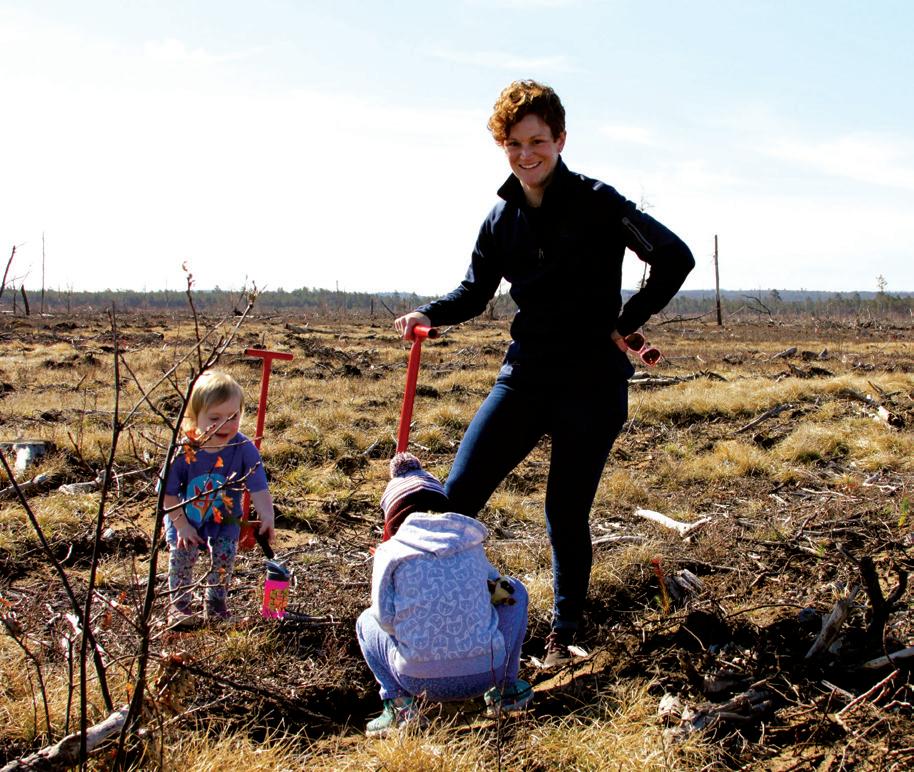
New Partnership Builds on Warbler Success | 9
Community Program Director Abby Ertel plants jack pine seedlings with her children in 2019.
Volunteers at a rainy jack pine planting day in 2014.
Seth Lanning, a 2021 Huron Pines AmeriCorps member, collects native plant seeds from a pine barren ecosystem.
Timberland Restored
Past Project Inspires Family to Pull 70-year-old Dam From Upper Tittabawassee River
Joan Kreckman reclined in the shade of her sun hat and marveled at the quiet river flowing at her feet.
For seven decades, a dam stood in the way of the West Branch Tittabawassee River at this spot where Joan sat on the riverbank. Up until this moment, the roar of water rushing through the concrete and steel structure would have been almost deafening. But the dam was gone now, having been reduced to rubble by a demolition crew that morning, and Joan was basking in the unbroken natural sounds of the river valley.
“You can hear a ripple,” Joan said. “The whole look and feel of the river has changed. It’s very peaceful.”
The West Branch Tittabawassee River winds through this heavily forested private property in southeast Roscommon County, where dense woods and shaded streams have made it a popular place for generations of sportsmen and earned it the name “Timberland.”
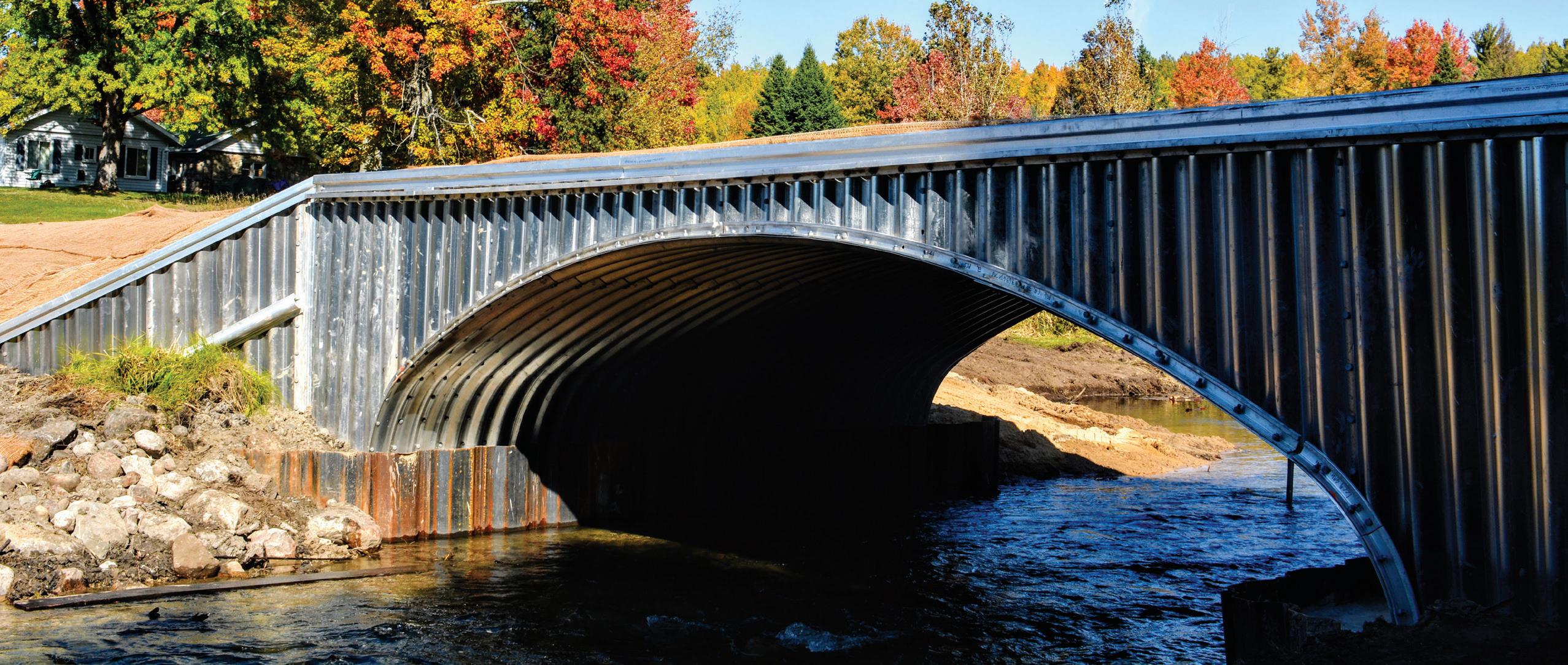
Built around 1950 to create a pond for fish and wildlife, the dam would remain in the river for the next 70 years. The dam’s concrete spillway, which acted as a two-foot vertical wall, kept fish from accessing more than 6 miles of quality, upstream habitat.
The Kreckmans understood the dam was not good for the river.
“We knew, eventually, the dam would need to be addressed,” said Todd Kreckman, the landowner and Joan’s son. “I wasn’t willing to put that off onto the next generation.”
Action Inspires Action
It was a news article about a 2019 dam removal project that Huron Pines managed on Middle Branch Cedar River, in neighboring Clare County, that prompted Todd Kreckman to call us about removing his dam. That project reconnected 9.2 miles of habitat in the Cedar River Watershed, eliminated the risk of a washout, and left landowner Bob Gingery with a healthy trout stream meandering through his property.
“The river has found its original course again,” Gingery said. “I’ve definitely seen more brown trout since the dam came out.”
Along with taking out the dam, additional effort was made to restore the river. Sand traps were dug to capture sediment, and long rolls of coconut fiber were laid along both sides of the stream to promote the growth of new vegetation and stabilize the banks.
“It’s nice to know someone read about this project and thought they could apply it to their situation,” Gingery continued. “If you have a structure that’s as old as mine was, you’re looking at it failing sooner or later. Working with Huron Pines to remove this dam was a great decision.”
A River Reconnected
D emolition and removal of the Kreckmans’ dam on the West Branch Tittabawassee River occurred in July 2022.
Dams like these slow a river down, giving it more time to gather and hold heat from the summer sun. Warm water carries less oxygen for fish, promotes algae growth, and has other negative effects on the ecosystem both upstream and downstream of a dam. Areas of stagnant water gather more sediment and become shallow, while water rushing over a spillway contributes to erosion which smothers important gravel habitats under a layer of fine silt.
Joan, matriarch and de facto foreman of the Kreckman family, observed from a safe distance as heavy machinery chiseled and clawed away the rubble from the river. She was there four days a week, watching in real time as the river began to heal, while crews assembled the 30-foot aluminum arch culvert which would become the family’s new bridge to the south side of the river.
Top: The new culvert crossing the West Branch Tittabawassee River at the Kreckman property known as Timberland.
10 | Huron Pines 2022 Annual Report
“We knew, eventually, the dam would need to be addressed. I wasn’t willing to put that off onto the next generation.”
“This was not something we could do on our own, and Josh made it really easy to do the right thing,” Joan said. “I hope this encourages more stewardship of our lands and more habitat restored.”
Huron Pines Senior Project Manager Josh Leisen saw the effort through from its planning stages in early 2020 to its completion in November.
“The upper Tittabawassee River Watershed has several high quality, coldwater trout streams that are in really good condition, and the West Branch is one of the best in the bunch,” Leisen said. “The Kreckmans are a family of anglers who understood the negative impacts of the dam and we were eager to work together for the benefit of the river. By removing the dam voluntarily, the Kreckmans have helped make this river even better.”
This project was supported by the U.S. Fish & Wildlife Service, Michigan Department of Natural Resources’ Fisheries Habitat Grant Program, a contribution from the landowner, Saginaw Bay Watershed Initiative Network, the Saginaw Bay Watershed Restoration Fund of the Bay Area Community Foundation, and Walters Family Foundation. Engineering was provided by Huron Engineering and Surveying, Inc. Construction services were completed by Jordan Intercoastal, LLC.
Dam Removals on the Horizon
H uron Pines has three dams on deck for removal in 2024. Meanwhile, there are hundreds of small, privately owned dams scattered across Northern Michigan, the vast majority of which were built decades ago before any meaningful regulations existed.
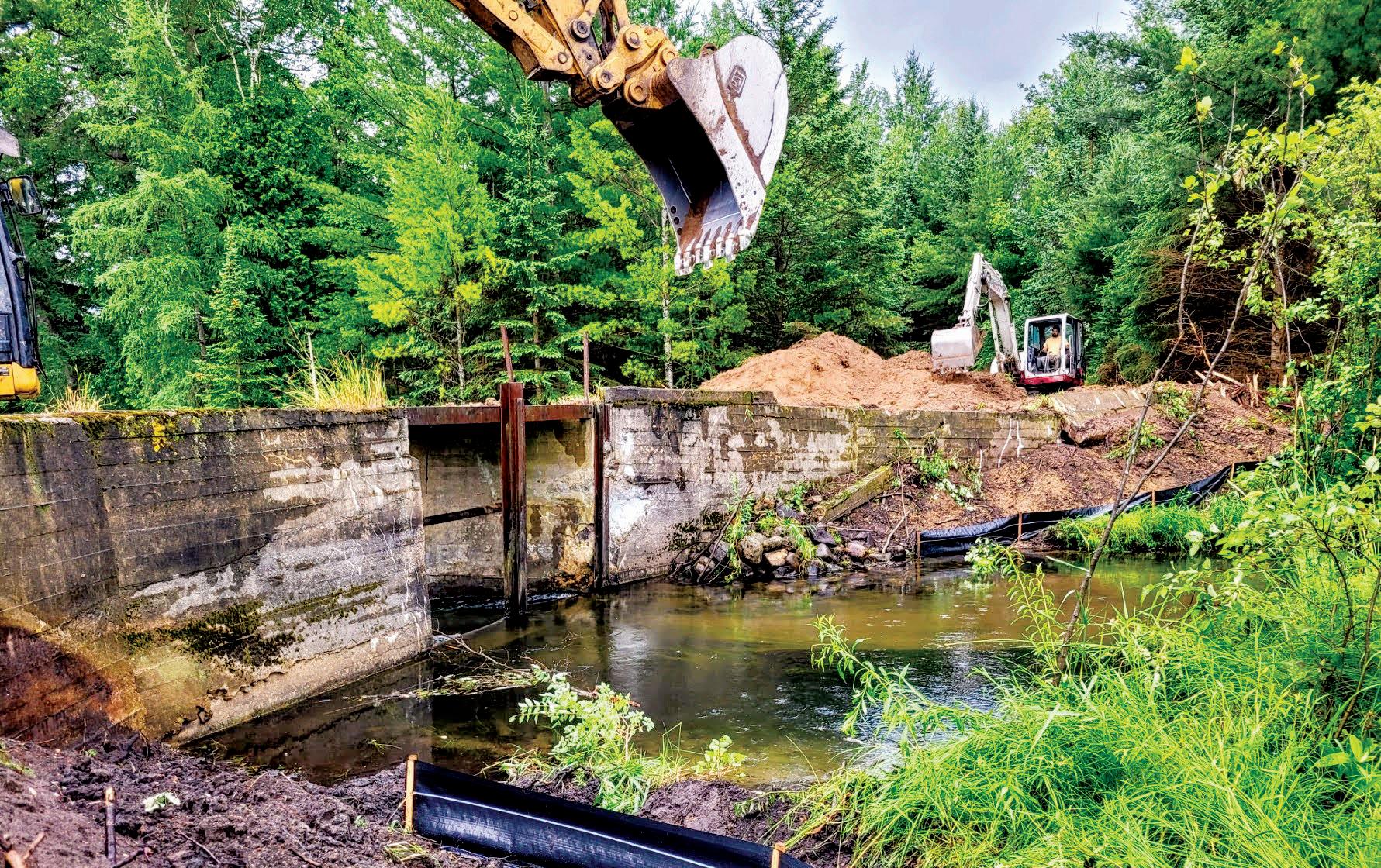
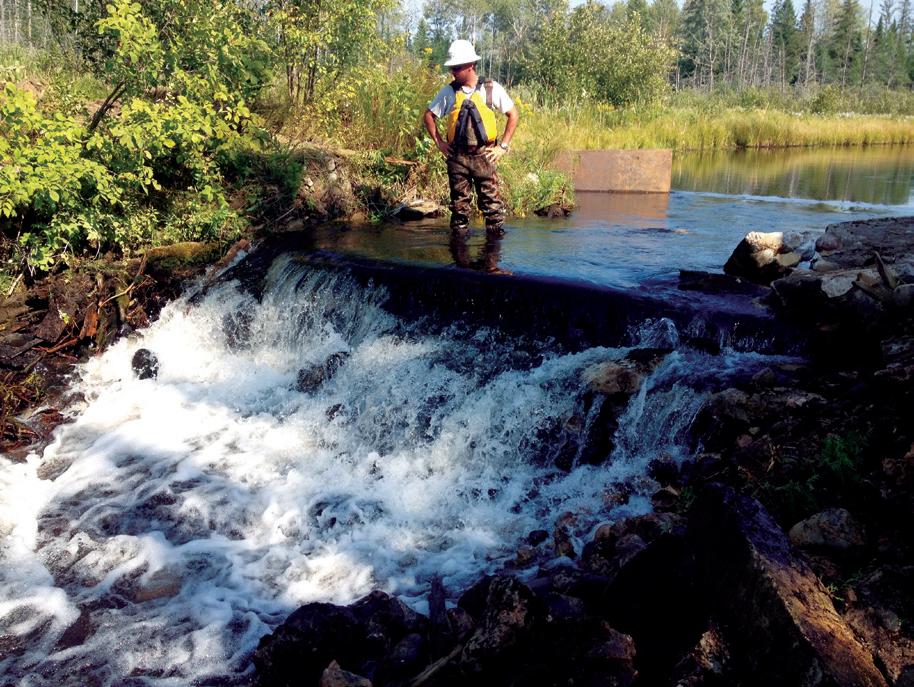
“We’ve come to understand as a society that streams are a public resource and now there are laws to prevent new structures from being built,” Leisen said. “In the meantime we’re left with aging structures that have a substantial, cumulative impact on our watersheds and need to be addressed.”
Landowners who have dams on their property are welcome to contact Huron Pines with questions pertaining to permitting, funding, project management and to discuss potential options to remove their structures.


Black River Reconnected
In 2011, the Michigan Department of Natural Resources acquired the 517-acre Saunders Tract and a mile of the Black River on the southern edge of the Pigeon River Country State Forest. That acquisition came with a concrete and stone dam which had stood in the Black River for four decades and prevented the upstream movement of wild brook trout.
Huron Pines removed the structure in 2013, reconnecting 8 miles of coldwater habitat on the famed brook trout fishery. Today, a gently sloping riffle marks the site where whitewater once churned over Saunders Dam.
The project was supported by the U.S. Fish and Wildlife Service Partners for Fish and Wildlife Program and Fish Passage Program, Michigan Department of Natural Resources, Upper Black River Council, Headwaters Chapter of Trout Unlimited and individual contributors.
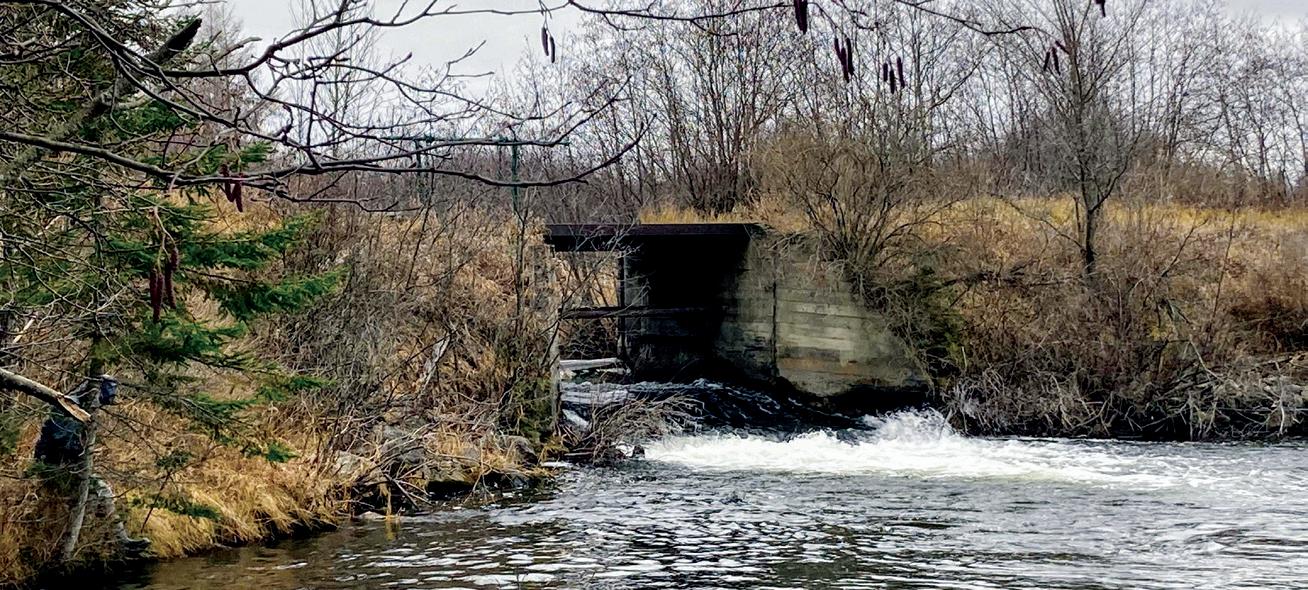 Restoration site in summer 2022
Restoration site in summer 2022
Timberland Restored | 11
Saunders Dam in 2013
Demolition of the dam at Timberland in July 2022.
The dam at Timberland in November 2020.
Working Around Rare Wildlife
Staff trained to protect Michigan’s most sensitive species
Rare ecosystems tend to hold rare species, and the work we do across Northern Michigan to restore these landscapes puts Huron Pines staff in close proximity to wildlife whose populations rely on special protections to survive.
Our efforts to benefit Michigan’s most sensitive species goes back to 2007, when we enlisted volunteers and members of Huron Pines AmeriCorps to stabilize an eroding stream bank overlooking the spawning grounds of lake sturgeon (see sidebar). Today, our work takes us to places inhabited by eastern massasauga rattlesnakes, Hine’s emerald dragonflies, and a host of other plants, insects and wildlife recognized as threatened or endangered.
To better understand these species and ensure our efforts don’t negatively impact their habitats or populations, members of our team are actively being trained to survey for, identify and relocate them if necessary. Here are some examples of trainings we completed in 2022 to make certain these species, which help define Michigan’s identity, will always have a home.
To Benefit a Rare Beetle
Waist deep in her waders, Coastal Project Manager Amy Nowakowski coaxed the end of a dip net into the shadow of an undercut riverbank. She prodded gently, feeling for hidden snags, then withdrew her net and examined its contents in the sunshine.

Scrambling inside the mesh net were dozens of dragonfly and stonefly larvae — the kind of aquatic life Nowakowski would expect to see in a healthy cold-water stream — but she was on the hunt for something special: a striped brown beetle the size of a watermelon seed.
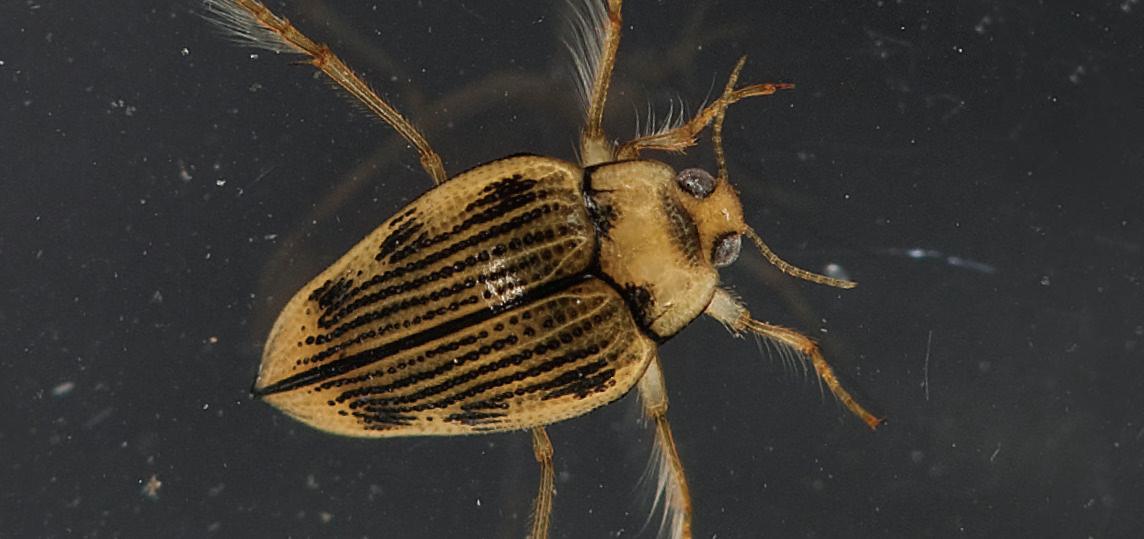
Hungerford’s crawling water beetle (HCWB), a critically endangered species, is found in only a handful of streams in Northern Michigan. In fact, there are only nine known locations in the U.S. and three in Canada where these beetles have been found. These known locations represent the last relict populations of the species, where they have been hanging on for the last 10,000 years in small pockets of suitable habitat. The presence of HCWB in cold-water streams serve as bioindicators for stream health.
Nowakowski is among four Huron Pines Water Program staff trained and permitted to survey for the beetle.
“Very little is known about its geographic range or life history, so increasing our shared knowledge through training and surveys will contribute valuable data for the protection of this rare species,” Nowakowski said. “We hope to find populations of beetles in new locations to gain a better understanding of distribution and abundance in northeast Michigan.”
In 2023, with grant funding from U.S. Fish & Wildlife’s National Fish Passage Program, Huron Pines staff will survey 25 sites within and outside the beetle’s known range to better learn its distribution across Northern Michigan. The data will be shared with the U.S. Fish & Wildlife Service and will help determine the status of the beetle for future endangered species status changes.
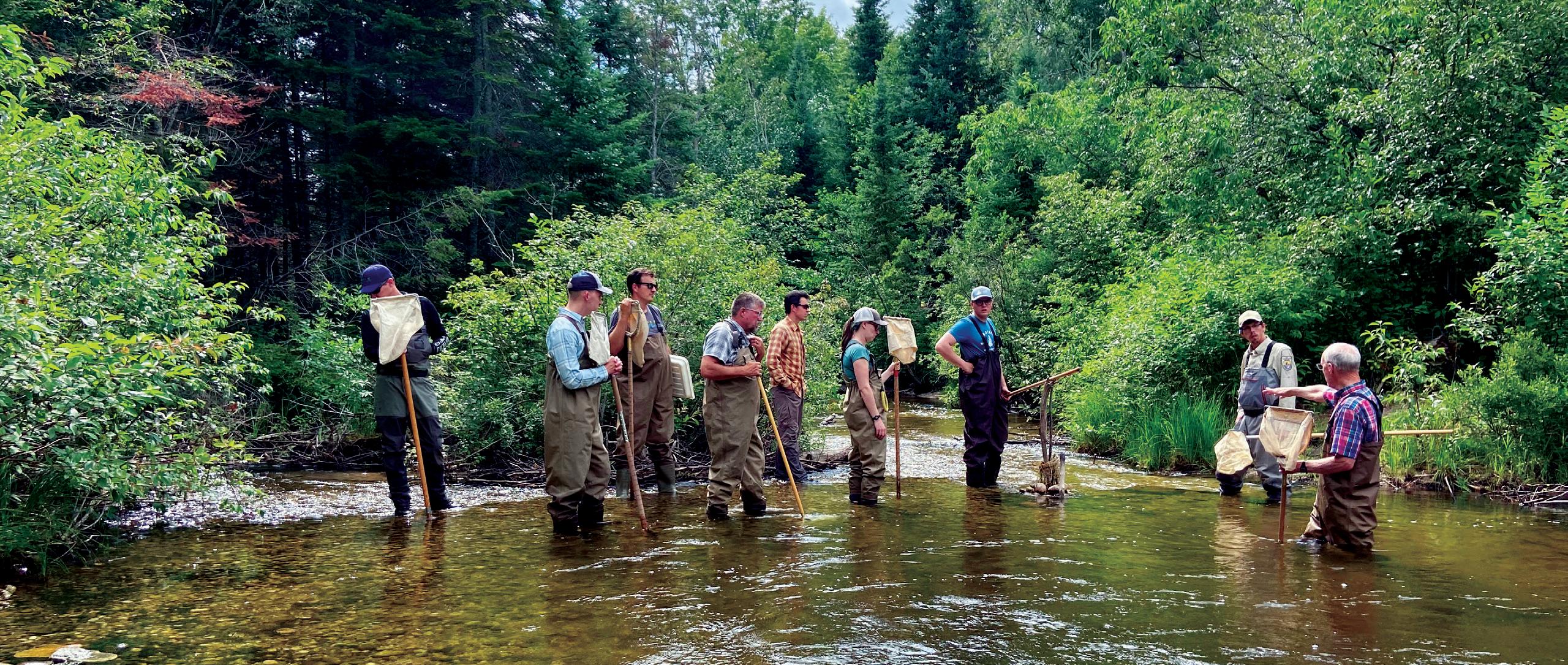
12 | Huron Pines 2022 Annual Report
Top: Water Program Technician Nick Theisen (third from right) participates in a training to survey for Hungerford’s crawling water beetle.
Hungerford’s crawling water beetle Brychius hungerfordi
Coastal Project Manager Amy Nowakowski surveys for Hungerford’s crawling water beetle at a Huron Pines stream restoration site.
Flexing Our Mussels
We’re taking similar steps to look for and identify species of Michigan’s native freshwater mussels, many of which are threatened or endangered and all protected accordingly under state and federal law.
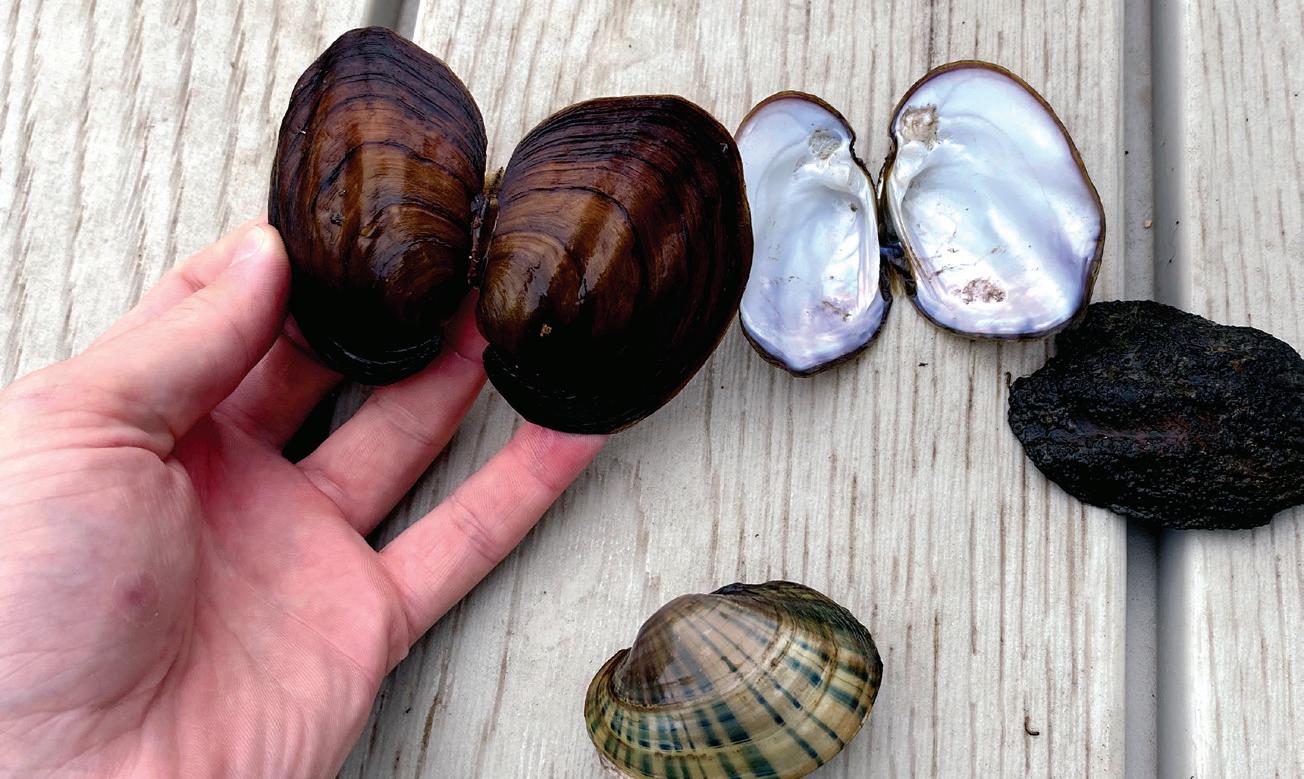
In September, Water Program Technician Nick Theisen completed a field training on the Grand River where he learned how to locate and identify native mussels like hickorynut, fawnsfoot, elktoe and snuffbox. Freshwater mussels are sensitive to environmental changes and pollution, and their presence and diversity in a stream are indicators of good water quality. They also filter excess nutrients from the stream and are a food source for wildlife like otters, mink and muskrat, making them an essential part of a river ecosystem.
“Our restoration efforts on Michigan’s rivers are for the benefit of all species,” said Theisen. “Being able to identify freshwater mussels teaches us more about these ecosystems and helps us better understand how our work will positively impact those habitats.”
This training was soon put to use when Theisen and his colleagues surveyed an undersized road/stream crossing site in the Manistee River Watershed due to be restored. Theisen found and identified a creek heelsplitter mussel, a species of special concern in Michigan, and photographed it before placing it back on the riverbed.
“With that information, now we’ll know to look for and relocate those mussels before our restoration work begins,” he said.
The mussel training was led by scientist and author Joe Rathbun and Grand Valley State University professor Eric Snyder. Our involvement was supported by the National Fish Passage Program.
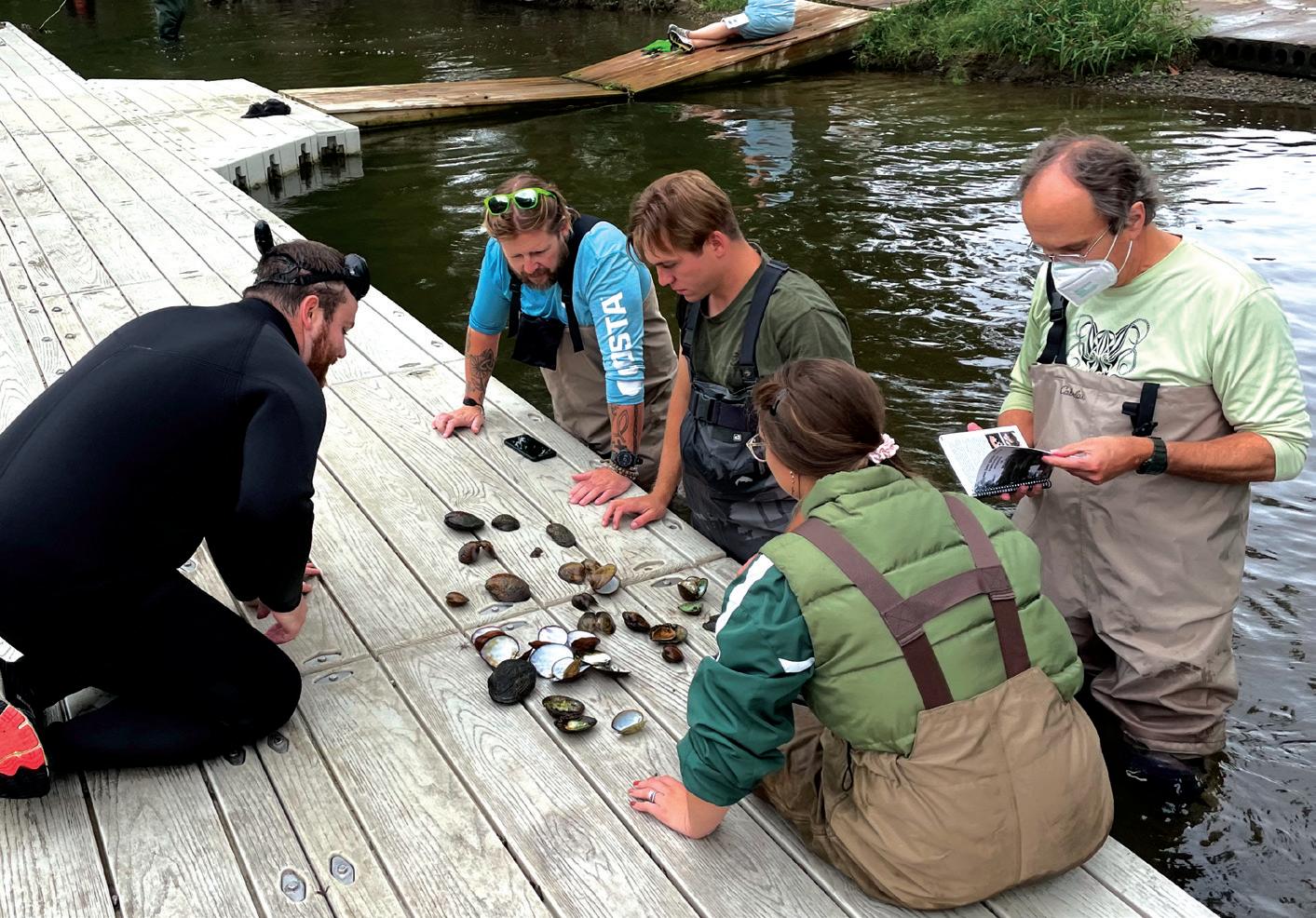
Supporting Sturgeon Habitat
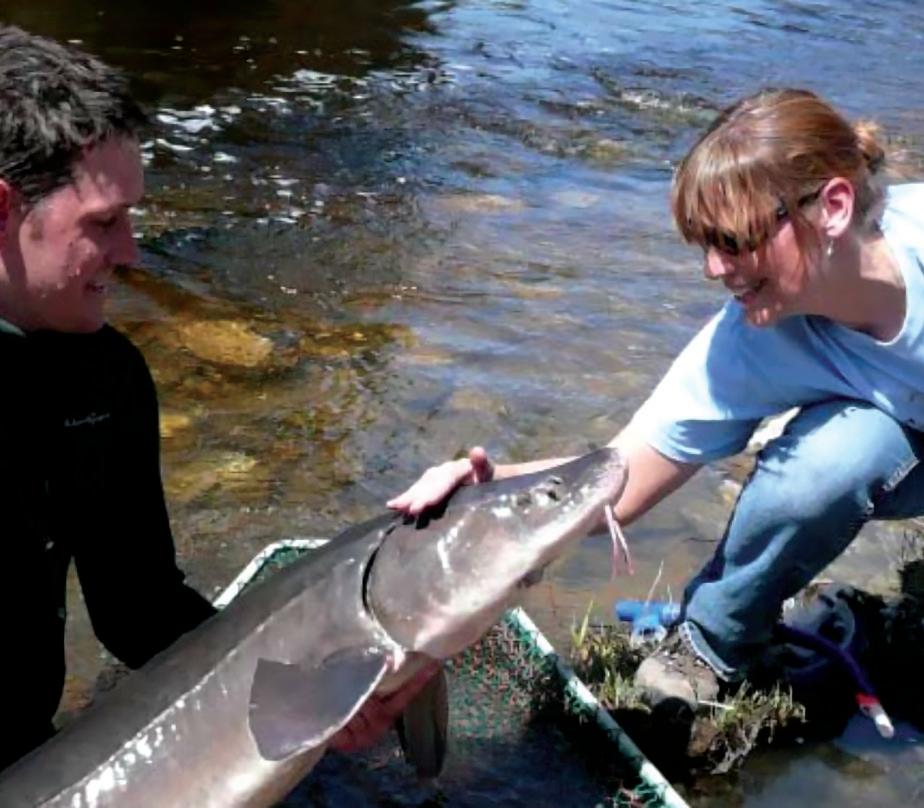


Efforts to benefit rare river life are nothing new for Huron Pines. Starting in 2007 and running for several years, our organization led efforts to restore erosion sites along the Black River where lake sturgeon spawn. Sturgeon lay their eggs on exposed gravel beds where they can be hidden from predators within the spaces between rocks and pebbles. Eroding stream banks input sand and sediment into the river where it buries these important gravel beds and significantly decrease the productivity of these fish.
We enlisted volunteers to replant and stabilize streambanks overlooking these spawning areas and occasionally caught glimpses of these massive fish — which can reach 9 feet in length and weigh 300 pounds — as they migrated upstream.
Working Around Rare Wildlife | 13
“The ability to identify these organisms will help inform our future restoration efforts and other activities that may impact these natural habitats.”
Conservation professionals learn how to identify freshwater mussels.
A Black River erosion site in 2009 after volunteers placed rock, topsoil and landscape fabric and then installed over 3,000 native plants.
Associate Director Lisha Ramsdell (right) meets a male lake sturgeon held by an MSU researcher in 2008.
Engaging Volunteers & Community Voices
Northern Michigan’s identity is shaped by water. Tourism, recreation, environmental health and community well-being are all tied to water quality.
Protecting our shared waters is paramount for Huron Pines and propels our stormwater efforts forward.
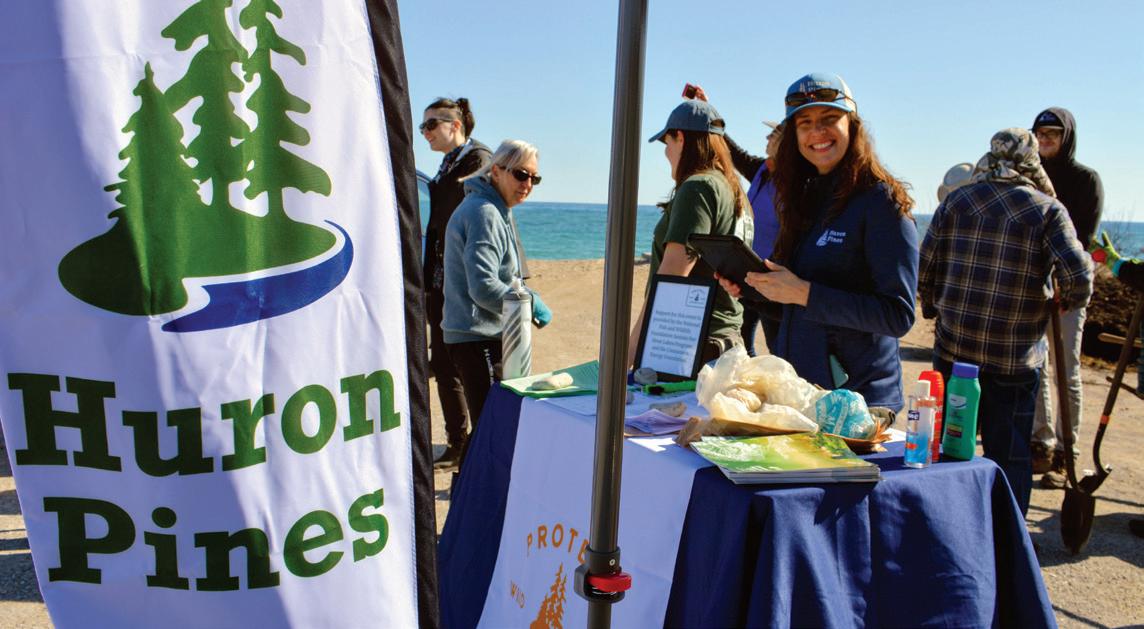
Stormwater — rain and snowmelt — carries road salt, bacteria, sediment and motor oils from roads and parking lots to nearby waterways. Once they enter rivers and lakes, these contaminants result in beach closures and degrade habitat for fish and wildlife. These impacts are amplified in coastal communities where lifestyles are defined by Lake Huron.
Our intensive focus on the health of Lake Huron and its surrounding watersheds drove our community engagement efforts in three coastal communities in 2022 and will continue to do so in the years to come.
Volunteers Plant a Forest on Rogers City Shoreline
In May, 40 volunteers joined the staff of Huron Pines and the Presque Isle Conservation District in planting, mulching and watering 500 trees along the Lake Huron coast in Rogers City. Species planted were balsam fir, white birch and white cedar.
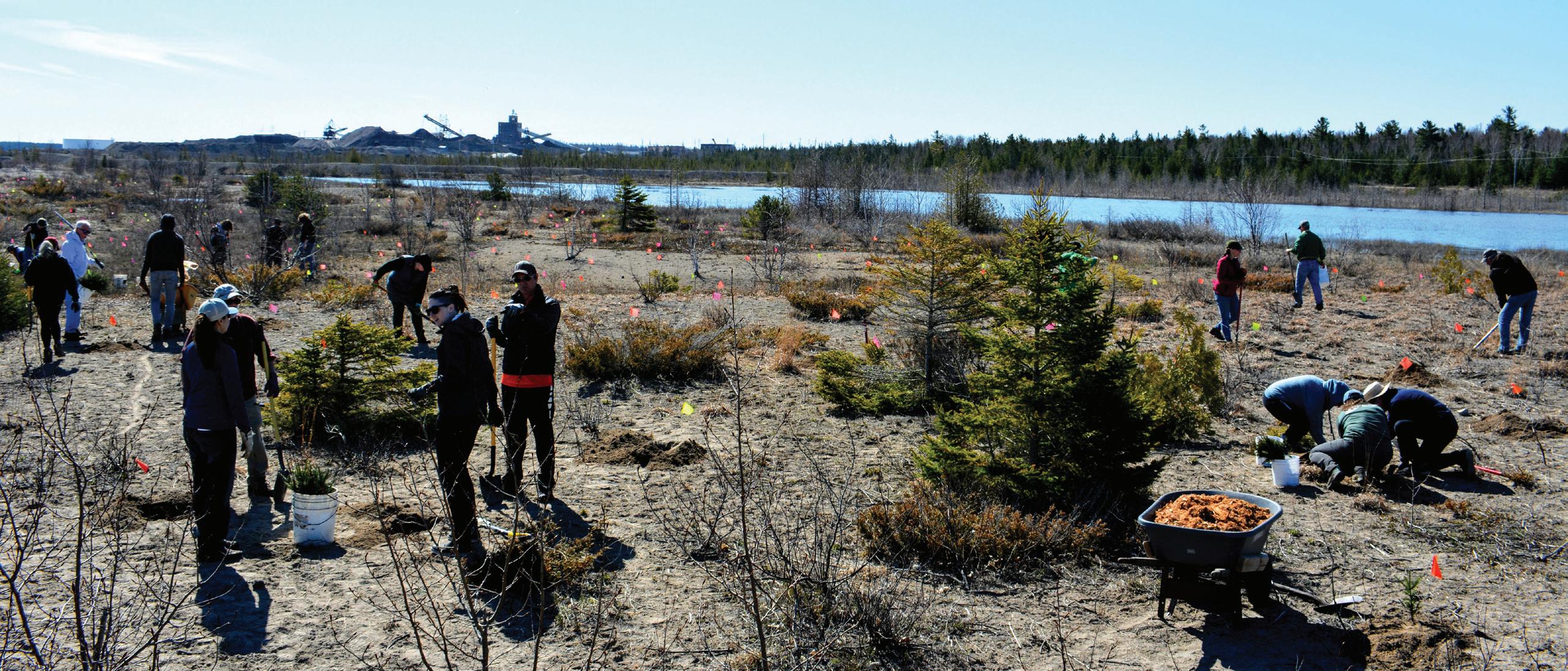
These trees capture stormwater runoff from a nearby baseball field and parking lot, and boost coastal defenses against strong storms. Adding more trees to the site will also contribute to the local genetic diversity, building resilience to disease and pests.
Tawas State Dock Gets a Splash of Color
On a sunny September morning, a dozen volunteers joined Huron Pines staff to install 1,000 native plants at the foot of East Tawas State Dock. These water-loving wildflowers and grasses add character to the shore. More importantly, they help filter stormwater runoff at one of Michigan’s most popular harbors.
This project followed treatments by our Stewardship Team to remove invasive phragmites and purple loosestrife from the site. Taking their place are bulrush, horsemint, blue iris, butterfly weed, beach grass, harebell, sand coreopsis and pearly everlasting. This diverse mix of hardy and colorful plants will stabilize the beach while capturing stormwater before it reaches Lake Huron.
“This is the last line of defense for filtering stormwater before it enters Tawas Bay,” said Water Program Director Samantha Nellis. “It’s also a place that’s highly visible to residents and visitors and will serve as an example of the good a natural shoreline can do.”
Support for this project and the Rogers City tree planting were provided by the National Fish and Wildlife Foundation Sustain Our Great Lakes Program and the Consumers Energy Foundation.
Top: Volunteers and Huron Pines and Presque Isle Conservation District staff plant 500 trees on a shoreline lot in Rogers City.
14 | Huron Pines 2022 Annual Report
Coastal Project Manager Amy Nowakowski greets volunteers.
The impacts of stormwater are amplified in coastal communities where lifestyles are defined by Lake Huron.
Public Input Drives Future Projects in Alpena
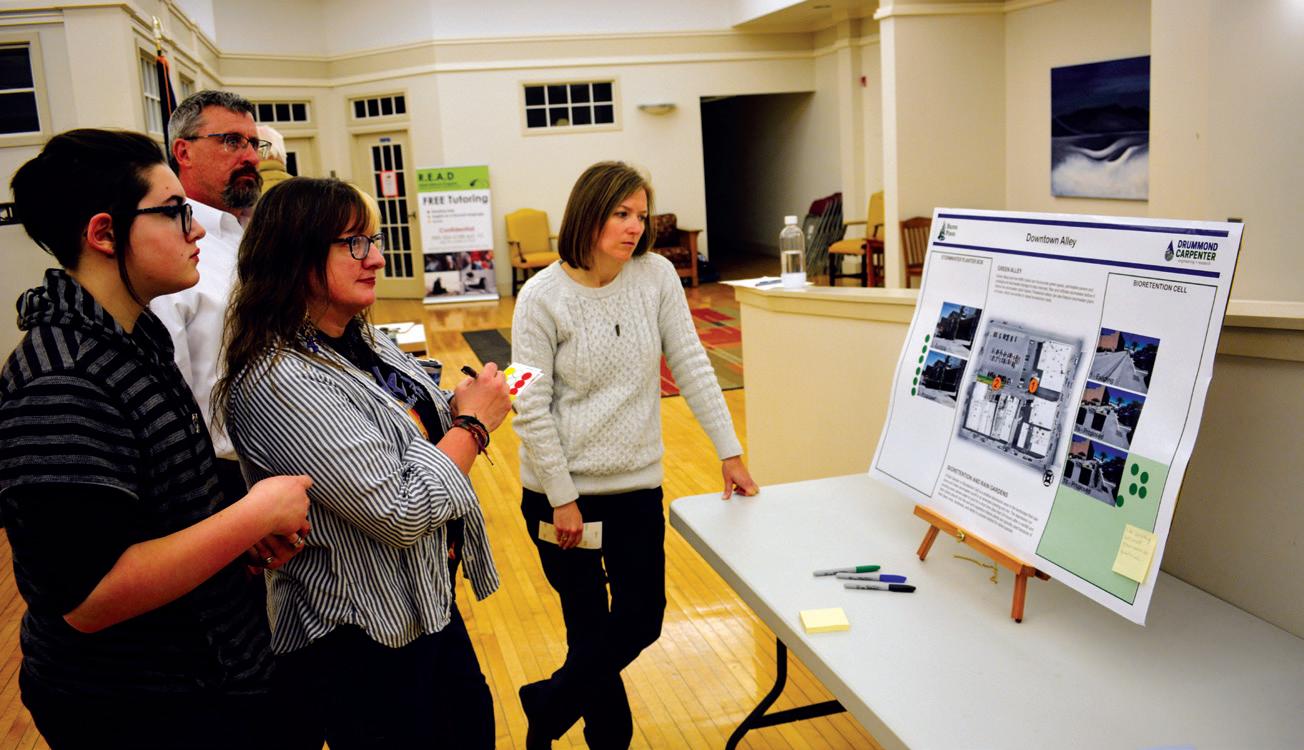

We introduced residents to examples of green stormwater infrastructure at an October stormwater visioning session in Alpena. Attendees had the opportunity to ask questions and rank proposed designs for future projects in their city.
Solutions presented at the meeting ranged from the installation of trees and planter boxes to narrow bioswales along parking lots. Afterward, an interactive map illustrating Alpena’s stormwater infrastructure was published online, along with a survey to gather public input on which proposals they preferred.
The most popular proposal was a dune-restoration project at Mich-e-ke-wis Park, a popular swimming beach and recreation area. Huron Pines is supporting efforts by the City of Alpena to pursue funding options for the project.
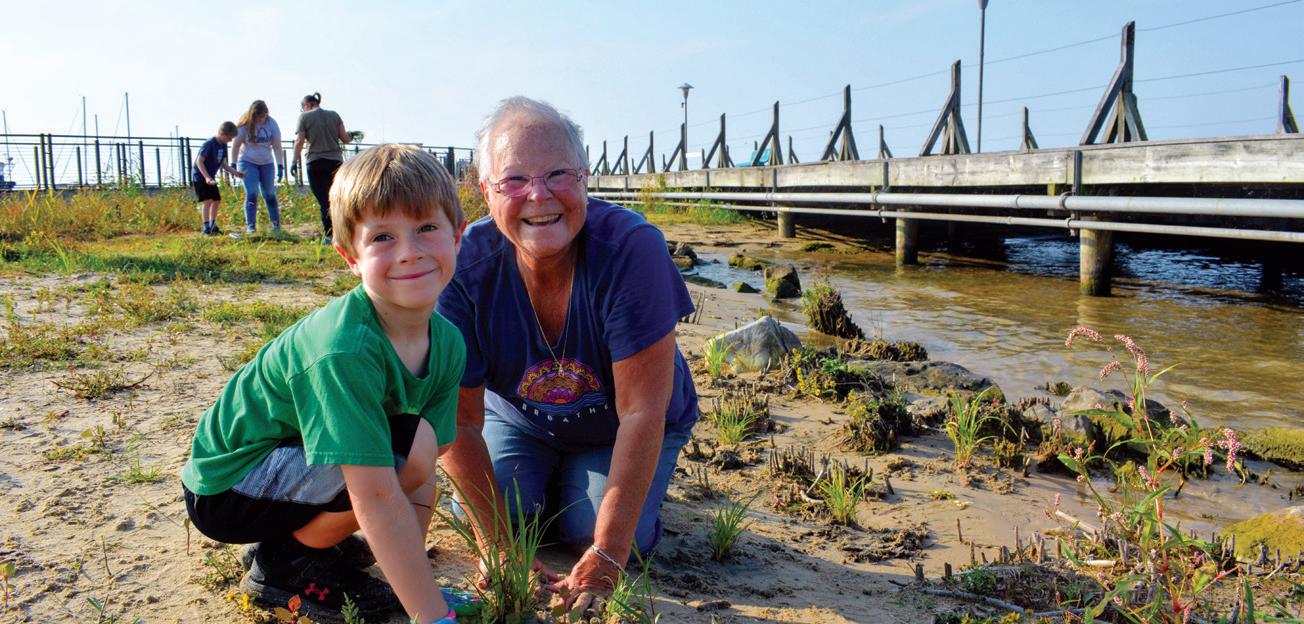

Funding support for the visioning session was provided by the Michigan Coastal Management Program, Water Resources Division, Department of the Environment, Great Lakes and Energy (EGLE) and the National Oceanic and Atmospheric Administration. Engineering firm Drummond Carpenter, PLLC provided project design illustrations.
A Decade of Stormwater Work
Huron Pines completed a citywide stormwater assessment for Rose City in 2012 and prioritized areas where new infrastructure would have the greatest impact. As a result of the assessment we installed a mechanical oil and grit separator in 2014 to treat stormwater runoff from Rose City, and celebrated with a community ribbon-cutting ceremony in October of that year.

The oil and grit separator is an underground stormwater treatment unit that captures sediment and oils from stormwater runoff before they reach Houghton Creek, a high quality tributary of the Rifle River. Efforts like these ensure the watershed will remain healthy and productive.
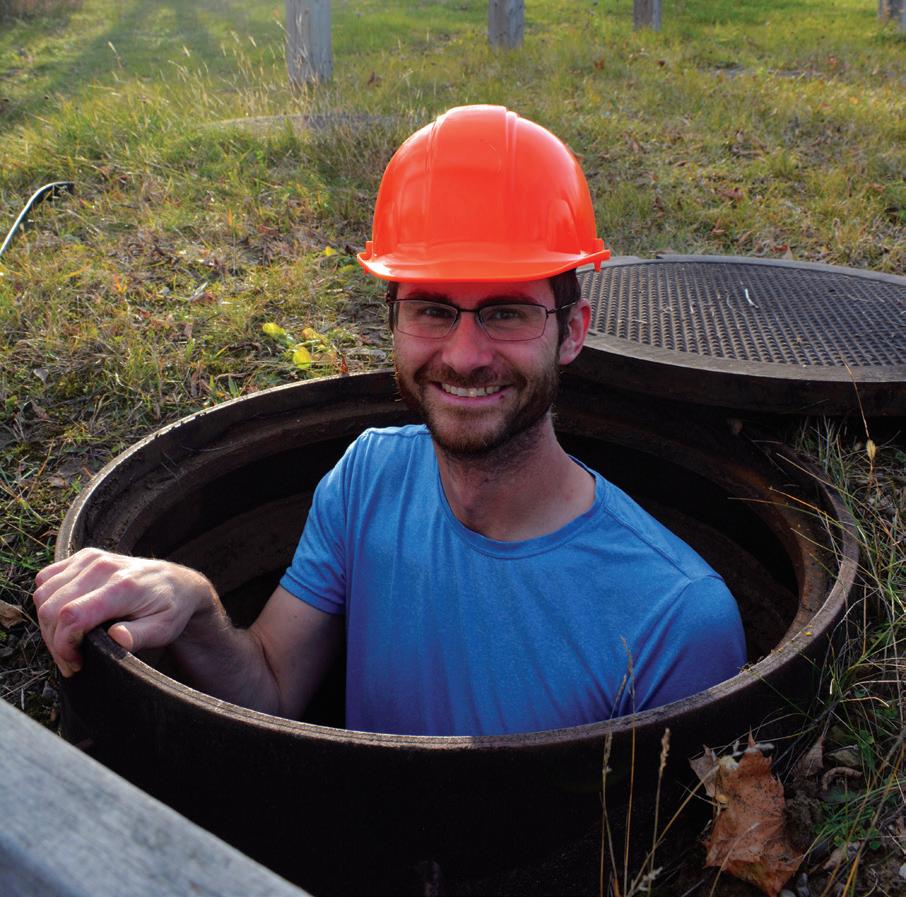 Senior Project Manager Josh Leisen inspects the silt separator in 2022.
Staff, partners and residents celebrate the silt separator with a ribbon cutting in 2014.
Volunteers Zeke Hill & Chris Preston install plants near Tawas State Dock.
Land Protection Coordinator Julia Butch — then a member of Huron Pines AmeriCorps — carries a flat of plugs to be planted near Tawas State Dock.
Senior Project Manager Josh Leisen inspects the silt separator in 2022.
Staff, partners and residents celebrate the silt separator with a ribbon cutting in 2014.
Volunteers Zeke Hill & Chris Preston install plants near Tawas State Dock.
Land Protection Coordinator Julia Butch — then a member of Huron Pines AmeriCorps — carries a flat of plugs to be planted near Tawas State Dock.
Engaging Volunteers & Community Voices | 15
Participants of an October visioning session consider and rank proposals for green stormwater infrastructure in Alpena.
It Takes A Village: How Volunteers, Local Leaders and Active Communities Drive Our Mission
At Huron Pines, one of our most important jobs is to bring people together.
We can accomplish more when we build partnerships, connect with communities and activate volunteers. We are lucky to have such a strong network of people ready to engage in the protection of Northern Michigan’s resources. Over the last year we’ve looked to you, our friends and partners, to become community scientists, to pledge your support for Lake Huron, to master your understanding of your environment and to act as tour guides showcasing your favorite natural places to visitors from across the state. Your work has helped drive ours and these are some of your stories.
Keeping an Eye on the Coast
In July, Huron Pines launched a community science monitoring program focused on the health of Lake Huron. In our volunteer Coast Watchers program, participants were trained to record air and water temperature, seasonal changes in water levels, and occurrences of sensitive or invasive plants, fish die-offs, storm damage or pollution. Volunteers are local residents who visit their designated stretch of shoreline once a week to collect information and contribute to a long-running data set on the condition of the Lake Huron coast.
Coast Watchers has been an important program of the Lake Huron Coastal Centre in Goderich, Ontario since 2005, and data collected helps guide their shoreline restoration efforts there. Huron Pines is now piloting the program on the Michigan side as part of the Lake Huron Forever Initiative, with the expectation that it can help guide and prioritize our future restoration efforts along the Northern Michigan coast.
Taking a Pledge to Protect Lake Huron
One of the underlying goals of the Lake Huron Forever Initiative is for coastal communities — and eventually communities across the Great Lakes region — to take a pledge of support for the long term health of Lake Huron. In 2022, our first two Lake Huron Forever communities were established after signing the pledge into action. Au Gres and Bay City each took the Lake Huron Forever Pledge which lays out the specific challenges facing a lakeshore community and the measures the community plans to take to address them.
For Au Gres, the pledge prioritizes efforts to reduce stormwater runoff, treat invasive plants, limit the use of fertilizers and herbicides on city
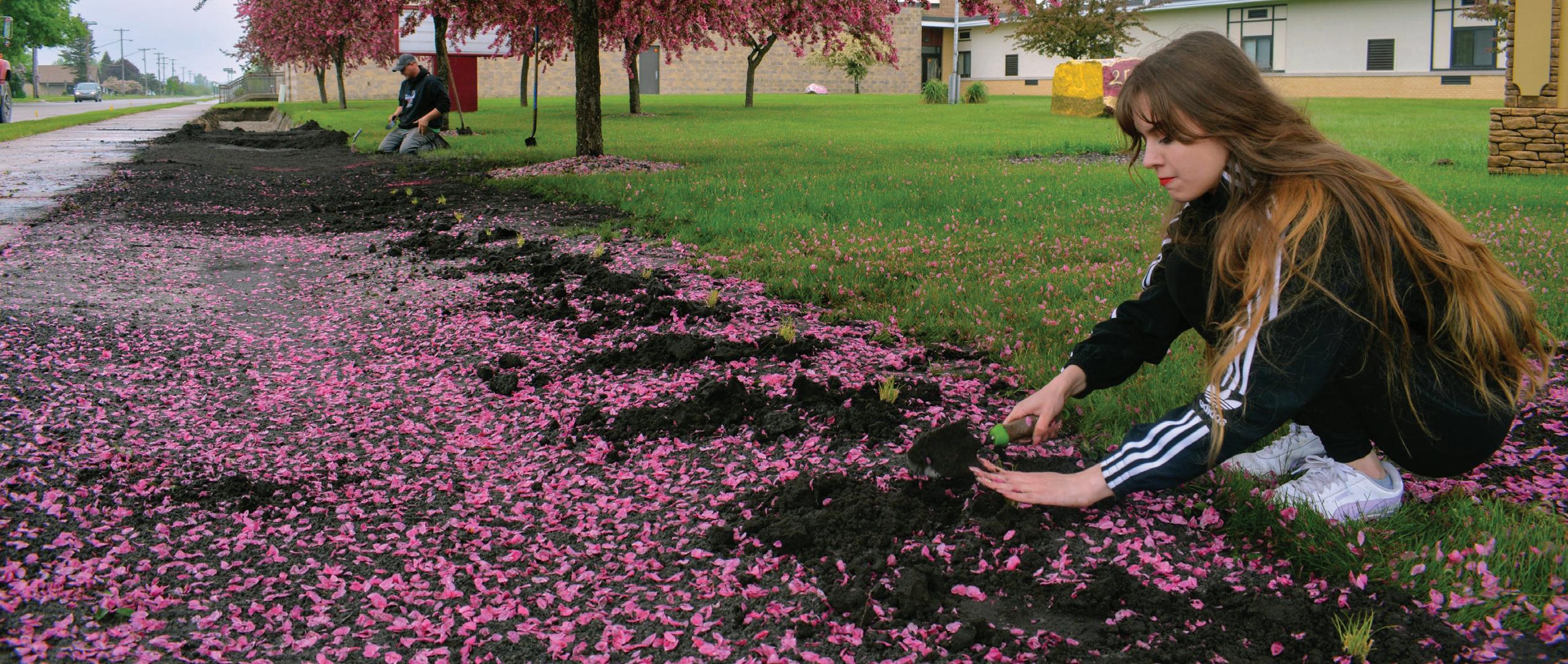
property, and promote environmental education to the general public. The community of Au Gres is a longtime and active partner of ours, and students of Au Gres-Sims Schools have been deeply involved in efforts alongside Huron Pines to install stormwater bioswales at two city parks and on school grounds.
Bay City is a more recent partner of Huron Pines. Its pledge emphasizes the reduction of stormwater runoff using nature-based solutions, improving the quality of natural areas, planting trees within the city to support biodiversity and urban resilience, expanding a recycling program, controlling the spread of invasive plants and promoting conservation education. Bay City will also work in partnership with its sister city of Goderich, Ontario to engage on a local level and learn from one another. Integrating pledge goals into city recreation and master plans will move both city and Lake Huron Forever goals forward.
Being a Lake Huron Forever Community helps cities prepare projects in support of their goals and be ready to break ground if grant funding becomes available.
Huron Pines is leading the Lake Huron Forever initiative in Michigan with funding from Bay Area Community Foundation, Community Foundation for Northeast Michigan, Consumers Energy Foundation, Michigan Department of Environment, Great Lakes and Energy and Saginaw Bay Watershed Initiative Network. Support is also provided by Northeast Michigan Great Lakes Stewardship Initiative, Michigan Sea Grant, Michigan State University Extension, and U.S. Fish and Wildlife Service.
16 | Huron Pines 2022 Annual Report
Above: Au Gres senior Natalie Hoadley installs native plants in a stormwater bioswale on school grounds in May.
“Integrating pledge goals into city recreation and master plans will move both city and Lake Huron Forever goals forward.”
Hands-on Mastery
Master Naturalist helps people cultivate an appreciation of the natural world through direct experiences with local habitats. In 2022, Huron Pines had the privilege of hosting the Master Naturalist program in Northern Michigan in partnership with Michigan State University Extension and Pigeon River Country Discovery Center. For six months, 30 participants from diverse geographies and backgrounds come together once a month at the Pigeon River Country (PRC) Discovery Center to learn about and explore Michigan’s natural communities.
Full-day sessions covered the Native American history and geology of the PRC, wetland habitats, wild elk, forest health, river ecology and more, all led by conservation professionals. The six sessions were held in person and included classroom learning and field trips throughout the PRC. Many of the participants have become more deeply involved with Huron Pines’ mission and are local champions of conservation since completing the program.
Maddie Khuri, Community Education Project Manager, helped lead and support Master Naturalist.
“It was really cool to bring people from across the state to the PRC to share some of the natural wonders of Northeast Michigan,” Khuri said. “It was inspiring to watch their appreciation and understanding of the natural world grow as they made their way through the program.”
Advocating for Northern Michigan

Through tours, community connections, public meetings and ongoing conversations with the Michigan Natural Resources Trust Fund (MNRTF) Board, Huron Pines is working to showcase the untapped potential for acquisition and development projects in the Northern Lower Peninsula.

The MNRTF receives revenue from oil and gas leases on public lands that can be appropriated to land protection and outdoor recreation projects. This is exactly what happened in the case of Alabaster Township’s award of a $1.7m MNRTF grant for the acquisition of Lake Huron Coastal Preserve (see page 7).
Huron Pines has two active roles in helping connect the MNRTF to Northern Michigan communities. We advocate on behalf of the communities we serve and help communities plan and submit projects to the MNRTF for funding.
In our role as advocates, Huron Pines had the privilege of hosting the MNRTF Board and Department of Natural Resources staff for a day of field trips ahead of their August meeting in Alpena. By highlighting our unique natural resources and connecting local leaders to the Trust Fund, we can help ensure a greater return on our investment in this treasured asset for the people of Northern Michigan.
Stewarding Island Park for Public Good
Huron Pines led numerous volunteer improvement projects on Island Park in the 1980s, including the construction of fishing platforms, trails, an accessible viewing deck and canoe launch.
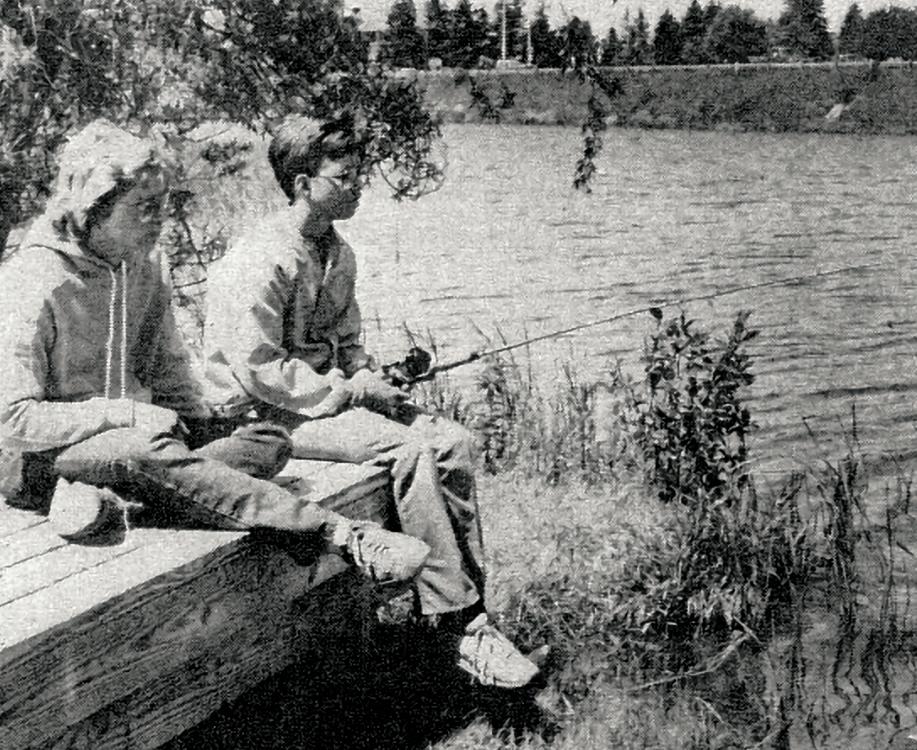
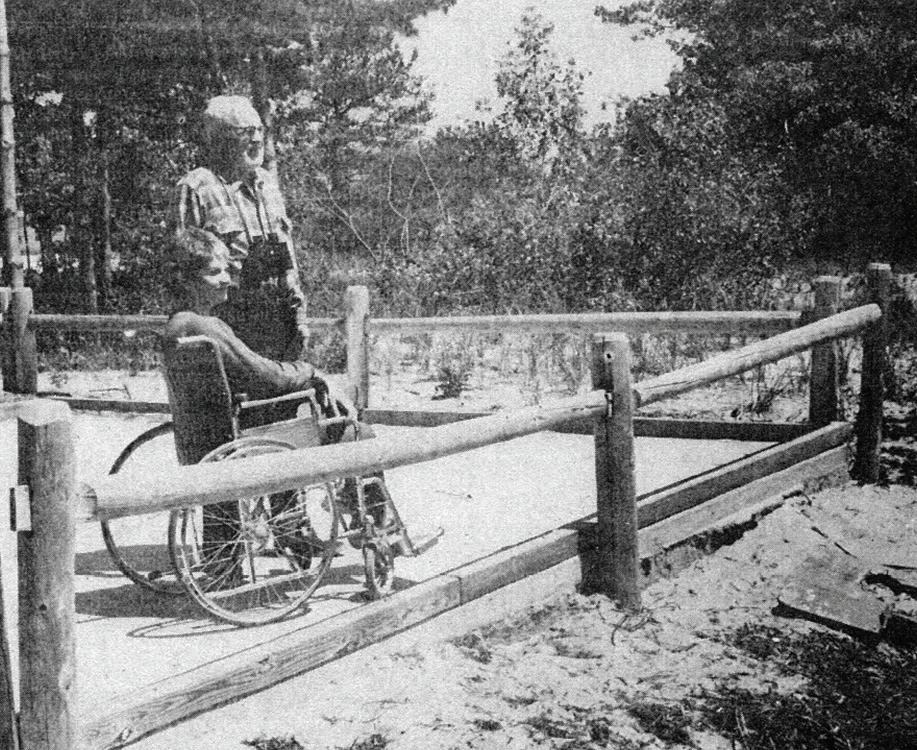
In 1985, the City of Alpena purchased the island from Alpena Sportsmen’s Club with the help of a grant from the Kammer Land Trust Fund — now the Michigan Natural Resources Trust Fund — which Huron Pines helped secure. The transfer was celebrated with a ribbon cutting ceremony that June.
Our stewardship activities here continue to this day, with annual volunteer efforts to remove invasive European frog-bit from the waters around the island and ongoing monitoring for invasive species.
It Takes a Village | 17
O.B. Eustis chats with Marsha Moers on Island Park’s accessible viewing deck overlooking the Thunder Bay River. Huron Pines staff and volunteers installed the platform in the 1980s. Photo coutresy of The Alpena News.
People fish at Island Park in 1985.
Photo courtesy of The Alpena News.
Water Program Director Samantha Nellis discusses the importance of protected forest wetlands during a field tour for the Michigan Natural Resources Trust Fund Board in August.
Compelled to Serve
The Huron Pines AmeriCorps program has been developing leaders in conservation in communities across Michigan since 2007 and is one of the longest running environmental-focused AmeriCorps programs in the state.

Huron Pines AmeriCorps members strive to enhance Michigan’s natural resources and foster environmental stewardship by engaging local volunteers, community groups and schools in environmental service projects, hands-on learning opportunities and educational workshops.
In the last 17 years we’ve seen more than 400 members come through the program and their accomplishments, both during their service and beyond, have a significant and lasting impact on the communities in which they serve.
Here’s a look at a few of our recent members and how their service shaped their careers and propelled the mission of their host sites forward. Their innovation is a model for the future of conservation in Michigan and exemplifies the best of Huron Pines AmeriCorps.
Bringing Service Full Circle
In 2019, Kyler Moran moved to the Traverse City area excited to serve the Northern Michigan community through environmental stewardship. As a person with a passion for land protection, Moran accepted a service position with the Grand Traverse Regional Land Conservancy (GTRLC) as their Preserve Stewardship Technician. He enjoyed his service so much that he decided to stay on for a second term in 2020.
During his two terms, Moran helped restore hundreds of acres of habitat, led numerous volunteer workdays, spearheaded a bat-monitoring program
on preserve lands and helped pilot recreational-use surveys to quantify the health benefits of spending time in nature.
Following his service, Moran accepted a full-time position as the Preserve Stewardship Manager at Legacy Land Conservancy in Ann Arbor.
“My career would not have been possible without my service through Huron Pines AmeriCorps,” he said. “Throughout my two years with the program, and at GTRLC, I learned the fundamentals of working for a land trust and gained great interdepartmental experience. I made valuable connections, personally and professionally. My service truly propelled my career.”
In his new role, Moran advocated for Legacy Land Conservancy to become a Huron Pines AmeriCorps host site, and they received their first member in 2022. Two members are serving there in 2023 under his leadership.

Moran’s passion for the HPA program is tangible.
“As a host site supervisor, I’m looking forward to mentoring our members, giving them valuable experiences and building their professional networks,” he said.
Offering a New Perspective
Looking for a new opportunity to grow her professional network and skills within the natural resources field, Kate King accepted a Huron Pines AmeriCorps position with the Michigan Department of Natural Resources (DNR) in Gladwin, serving through 2020 and 2021.
Throughout her two-year service, King was involved with Adopt-a-Forest, the DNR’s volunteer forest clean-up program. She spent many hours patrolling state land looking for sites where people had discarded trash and debris, logged their descriptions and locations in a database, and then made a plan for proper removal and disposal. Items like tires, scrap metal and cardboard would get recycled but there was no protocol for one item she kept finding: fiberglass boats. A lot of them.
18 | Huron Pines 2022 Annual Report
“My career would not have been possible without my service through Huron Pines AmeriCorps.”
Eager to remove these boats from public lands and keep them out of landfills, King researched the possibility of recycling fiberglass and learned about similar efforts in other states.
“I wanted to figure out how we could make recycling fiberglass a profitable business for Michigan,” she said. “In Rhode Island, they are using fiberglass in cement. So I thought, wouldn’t it be cool if our walkways were made from fiberglass that came out of our forests?”
“Kate gave a voice to the problem,” said Maia Turek, Engagement and Innovations Specialist for the DNR who worked closely with King on the project. “The more people we talked to the more the idea snowballed. We have 24 stakeholder groups in multiple states who want to see something happen. Kate brought in a new perspective and we’re on the cusp of solving the problem.”
The DNR is continuing to work with the Michigan Boating Industries Association and other industry organizations to find a way to recycle fiberglass boats for Michigan and other states.
Leveraging Creativity for Conservation

A biology major in college, Brittany Tillman interned at DeVries Nature Conservancy in Owosso. Following her internship, she was encouraged by her supervisor to apply to Huron Pines AmeriCorps. She did so, and served in 2022 as Imperiled Species Education and Outreach Coordinator with the U.S. Fish & Wildlife Service in Lansing. In that role, she immediately became immersed in the world of educating and protecting Michigan’s rarest wildlife.

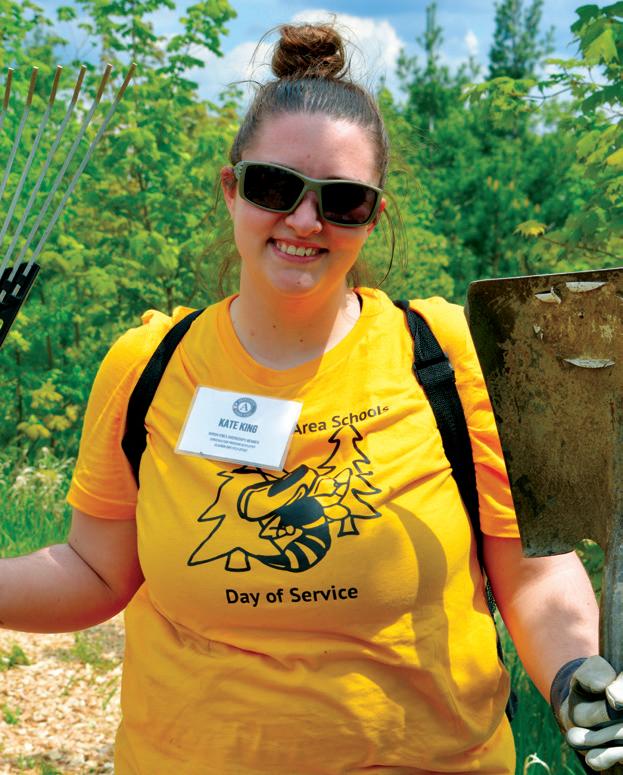
“My first time in the field I learned how to survey for freshwater mussels and found an endangered snuffbox mussel,” she said. “I’d been teaching others about this tiny creature, so it was a full-circle moment for me to actually see one in the wild.”
Tillman said her service helped build skills in communication and outreach through experiences in the field and public education programs. She gained confidence in herself while serving in the “welcoming and encouraging” atmosphere offered by her host site, and joined forces with other members serving at other host sites on collaborative projects.
One of those efforts was the Bee & Butterfly Outreach Program, which she built alongside fellow Huron Pines AmeriCorps member MaKayla Plekes. Together they led three pollinator-focused educational workshops, including one for high school students at Potter Park Zoo and incorporated a butterfly origami craft into the event as a fun way to engage students. Huron Pines AmeriCorps members with the USFWS are continuing to use the program in their outreach efforts.
“I loved getting to use my creativity for the purpose of education in order to engage a variety of audiences,” Tillman said.
Today, Tillman is back at DeVries Nature Conservancy where she works full time as the Environmental Education Coordinator.
First Recruits
The Huron Pines AmeriCorps program launched in 2007 and placed nine members with organizations around the state to help these groups reach their conservation goals. In that inaugural year, members engaged 466 volunteers in community projects, restored nearly 4 miles of river habitat and reached another 1,703 people through educational programs or other service roles.

Today, the impact of Huron Pines AmeriCorps continues threefold. We have 23 full-term members serving in 2023, along with a handful of members in half term positions. Their service benefits communities all across Michigan and has a lasting, positive influence on our natural resources.
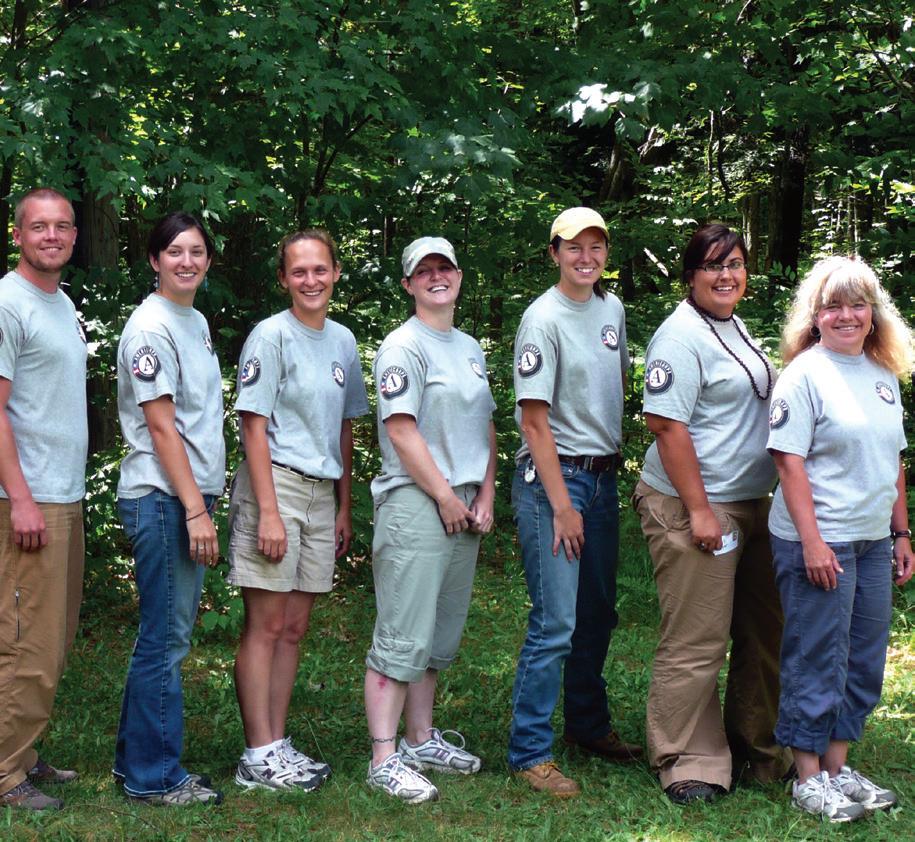 2007 members mark the completion of a 10-month service term with an end-of-year celebration.
2007 members mark the completion of a 10-month service term with an end-of-year celebration.
Compelled to Serve | 19
The first Huron Pines AmeriCorps cohort at Hartwick Pines State Park for orientation.
Kate King at a tree planting event at Vanderbilt Area Schools.
Brittany Tillman during a field day collecting and identifying mussels.
Obtawaing Biosphere Region
In 2021, this region was recognized by the United Nations Educational, Scientific and Cultural Organization (UNESCO) as a globally significant ecological and cultural landscape and was designated as the Obtawaing Biosphere Region (OBR).
Today there are 738 Biosphere Reserves around the world, nine of which are in the Great Lakes region. Obtawaing is Anishinaabemowin for “the middle ground or place of convergence and meeting” in recognition of the Anishinaabe tribal nations and the central location within the Great Lakes. The designation as a Biosphere Region provides a framework for bringing diverse, interdisciplinary partners together for the conservation of the region.
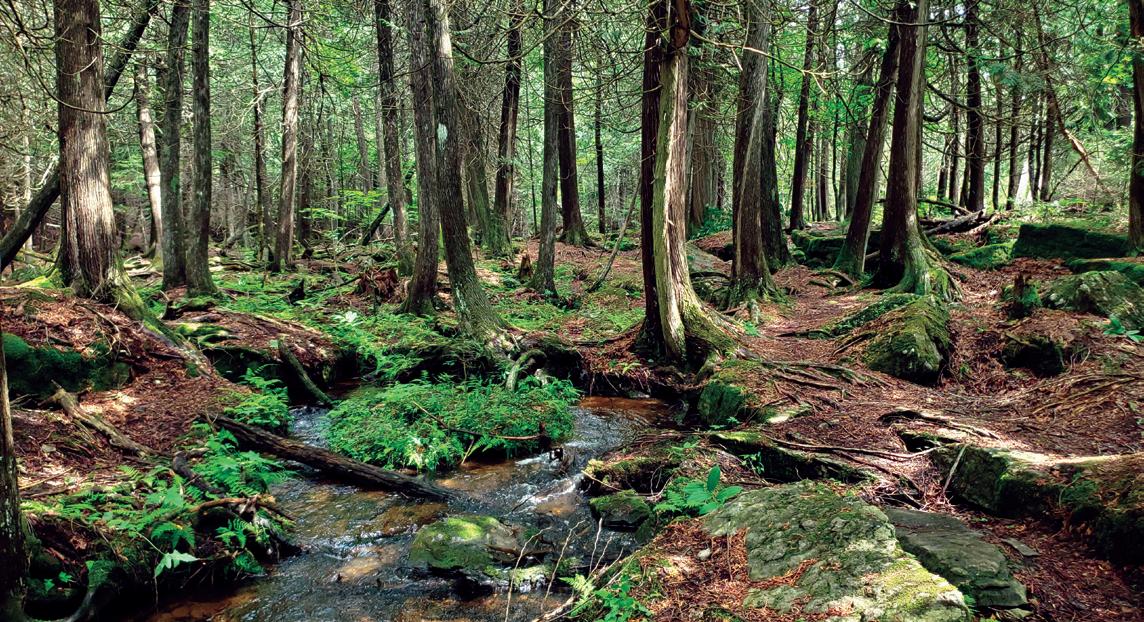
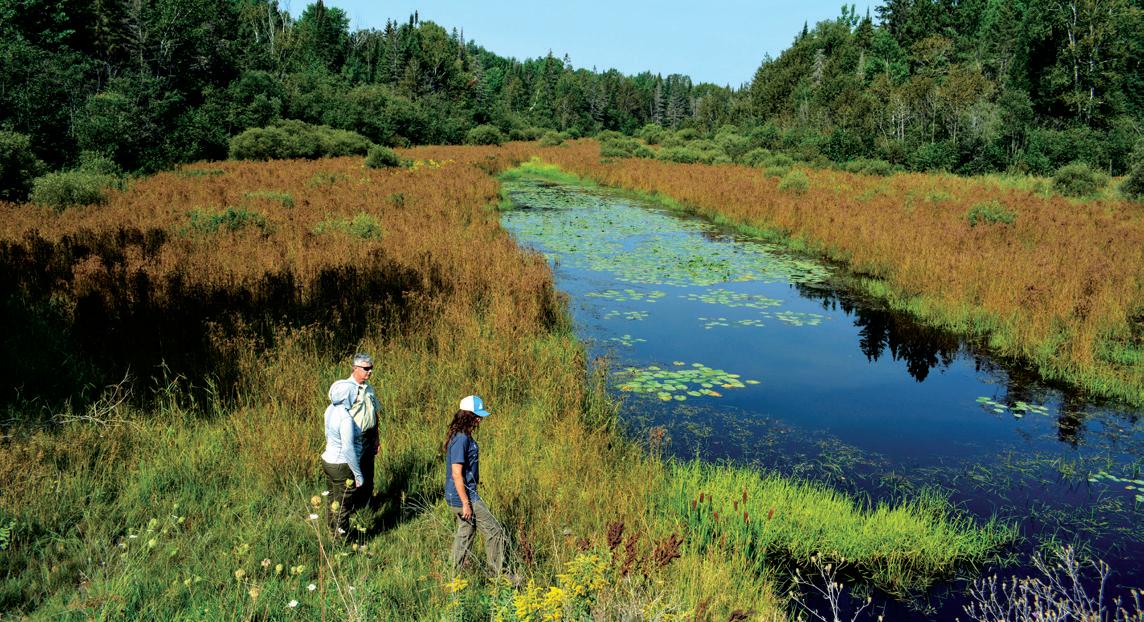
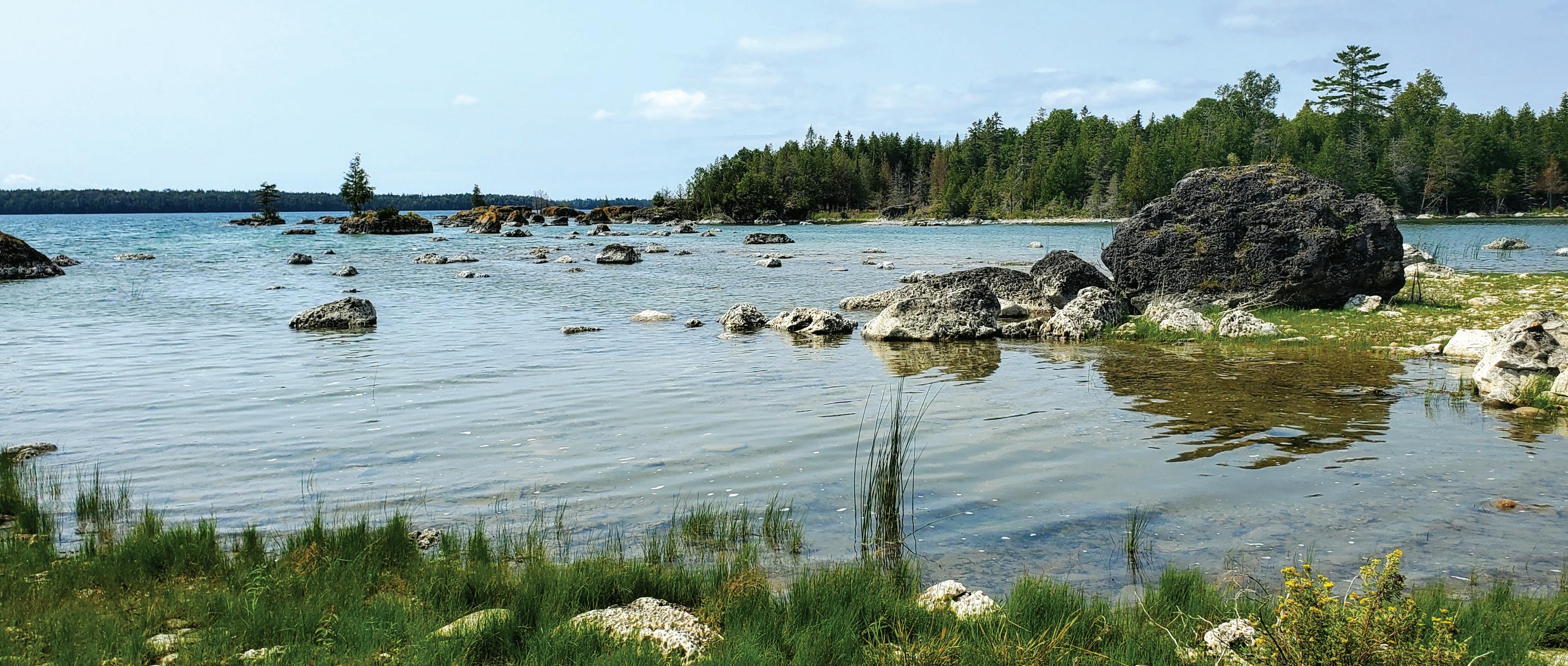
In 2022, the OBR Partner Network was formed and presently includes several conservation groups, universities, government agencies, tribal nations and other partners. The collaboration of these organizations allows us to think and talk about biodiversity and sustainability of this region on a larger scale. OBR partners share ideas and implement solutions to advance environmental, cultural and socio-economic sustainability and well-being in the heart of the Great Lakes region.
Additionally, the OBR is guided by the voices of five sovereign tribal nations. Their traditional ecological knowledge, and belief in humanity’s integral role within nature, has influenced the vision and strategy since the inception of the OBR.
In 2021, Samantha Nellis, Water Program Director for Huron Pines, helped develop the original strategic plan, which was spearheaded by the University of Michigan and driven by various tribal nations. In 2022, the strategic plan was finalized and Nellis accepted a role as a steering committee member for the OBR.
“I’m so excited that Huron Pines is taking a leading role in this effort,” says Nellis. “The UNESCO designation spotlights the global importance of this region and the amazing group of partners and collaborative nature has the potential to have landscape-wide, positive impacts for our communities and environment.”
Looking forward to 2023, the steering committee will continue exploring partnerships in the region in order to expand capacity and mitigate environmental impact in the face of a changing climate.
20 | Huron Pines 2022 Annual Report
Above: A shoreline view of the Lake Huron coast in the Eastern Upper Peninsula.
A site visit with partners in the Eastern Upper Peninsula.
A cedar forest in Presque Isle County.
At the convergence of the Upper and Lower peninsulas and Lakes Michigan, Superior and Huron lies a region well known for its fisheries, migratory bird corridors and nesting spots, plants and animals.
Obtawaing Biosphere Region

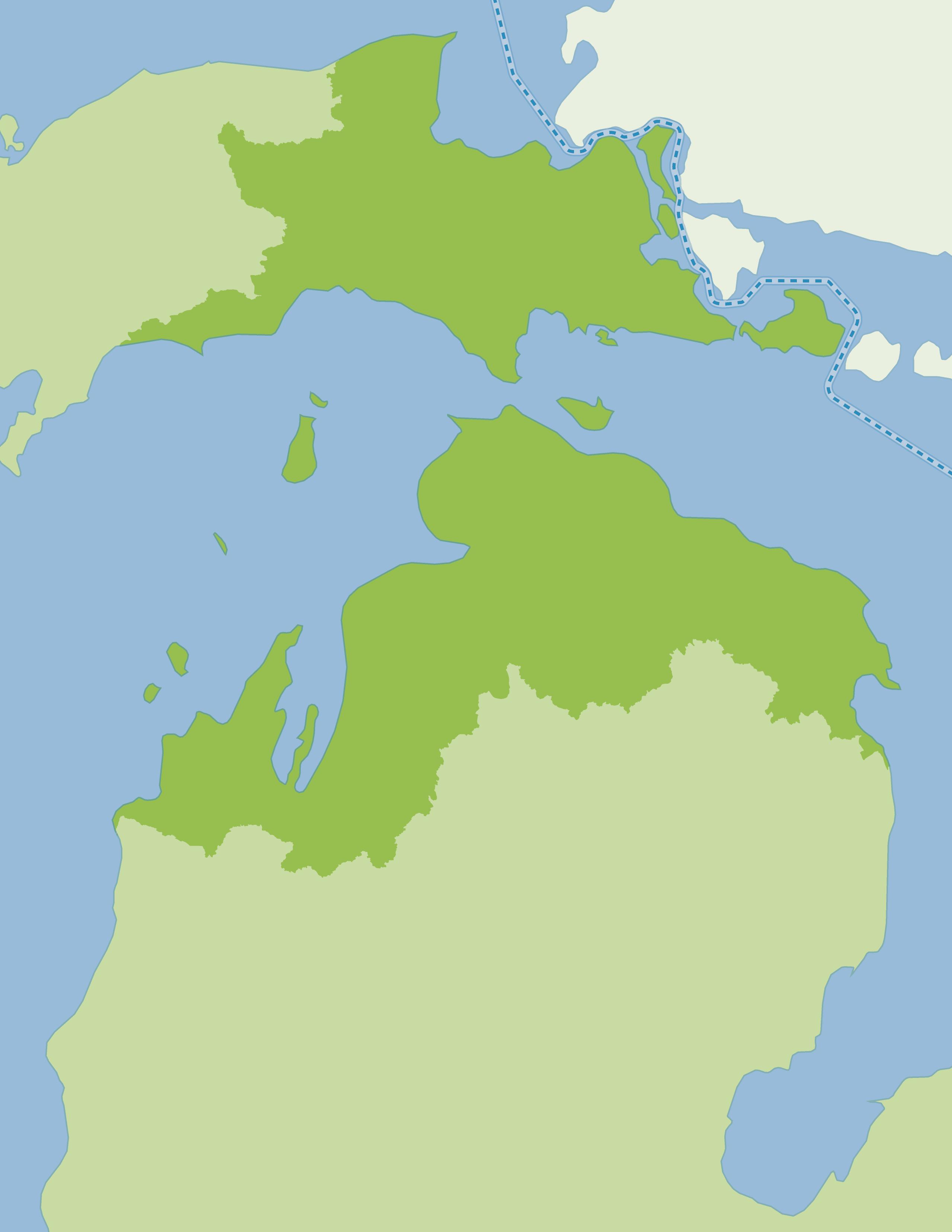
Michigan Great Lakes

International Border Canada
TOTAL AREA
8,029
(sq miles)
577 MILES OF SHORELINE 1,702
ISLANDS
A map of the Obtawaing Biosphere Region
The dune complex of Thompson’s Harbor State Park
Obtawaing Biosphere Region | 21
The northern Lake Huron coast
“The UNESCO designation spotlights the global importance of this region.”
Organizational Sustainability
At Huron Pines, we talk about sustainability often. From the communities we serve to the ecosystems we preserve and protect, sustainability in its many forms is a guiding principle. In recent years we’ve put more attention toward another facet of that principle – organizational sustainability. By this I mean the ability for Huron Pines to create a strong financial foundation that will last, serving our mission in a durable, flexible, yet consistent way as we empower our staff and the communities we serve.
We invested more into management and fundraising in 2022 than in the previous four years, as you can see in the table to the right. This is reflective of that focus on sustainability, to build our internal capacity in leveraging private contributions to match state and federal funding. Our revenue in 2022 was also higher than ever before, largely due to the incredible additions of North Point Nature Preserve and Birdsong Bay Nature Preserve, adding over $4 million to our portfolio.
As Huron Pines continues to grow, our land protection responsibilities highlight the need for long term funding to maintain these preserves for the benefit of natural communities and the enjoyment of local residents and visitors. With help from individuals, conservation partners and community foundations, we’ve established several permanent endowment funds to help ensure these assets are maintained and protected for years to come.
Through sound financial management practices, the generosity of our donors and attention to our organizational sustainability goals, we can take comfort in knowing Huron Pines will be here for our children, grandchildren and generations beyond. Huron Pines has been doing good work for 50 years and we’re looking forward to celebrating with all our friends later this year. Your support ensures our mission to conserve and enhance Northern Michigan’s natural resources will carry forward another half century and beyond.
Thank you,
Chip Erwin Board Treasurer
Our audited financial statements are available by request or on our website.
Five-Year Trend
$826,768
Vibrant Communities 31% $809,493 Protected Places 34%
2022 Net Assets
6,000,000 7,000,000 3,000,000 8,000,000 7,000,000 6,000,000 5,000,000 4,000,000 2,000,000 2,000,000 4,000,000 5,000,000 3,000,000 1,000,000 2018 2018 2019 2019 2020 2020 2021 2021 2022 2022 1,000,000 0 0
Total Revenue Program Expenses Total Net Assets Management and Fundraising Expenses $2,393,086 TOTAL
2022 Program Expenses 22 | Huron Pines 2022 Annual Report
Healthy Water 35% $756,825
Support a Sustainable Future for Northern Michigan

Planned Gifts = Meaningful Impact
Planned gifts are a powerful way to support the long-term success of our region.
As we celebrate our 50th year of natural resource protection in Northern Michigan, we are doubling down on our community-driven approach to conservation. Huron Pines continues to strengthen relationships with supporters and partners across the region, and our on the ground project list grows each year.
You have been supporting us to reach every corner of the region. Help us continue to make a meaningful impact on the future of the Great Lakes by ensuring the financial sustainability we need to keep our work going for another 50 years.
Bequest, Living Trust or Charitable Trust
Ensure that Huron Pines receives a valuable interest through your estate plans, either during life or after the passing of a donor. These valuable interests may include cash, stocks, full title to land or partial interests in land.
Required Minimum Distribution or Qualified Charitable Distribution (QCD)
For anyone 70 ½ and older, you are required to make an annual minimum distribution from your retirement plan. Minimum distributions can easily become donations to Huron Pines and provide you with significant tax advantages.
Huron Pines Endowment Funds
You can support our goal of organizational sustainability with a gift to one of our established endowment funds. We will help you match your donation to the fund that best fits your goals and passions.
Please call our Development Director, Heather Huffstutler at (989) 448-2293 x 11 to discuss these and other planned giving options.
Financial Overview | 23
“My heart bursts with gratitude for the work that Huron Pines is doing, so I just feel like it’s incredibly important to commit to the future through a bequest from my IRA.”
- Donette Spiekerman
Huron Pines legacy donor
In Recognition of Service: Judy Kalmanek
Judy Kalmanek, a tireless advocate for Huron Pines retired in December after eight years of service with our board.
Judy joined the board in January 2014 and assumed the role of Secretary the following year. She served on numerous committees as we expanded our efforts in land and water protection and opened a second office in Alpena, her hometown.
Judy has a special affection for Huron Pines AmeriCorps, which has been the springboard for hundreds of individuals pursuing careers in conservation, and supported annual efforts by our members to remove invasive European frog-bit from the waters around Alpena Wildlife Sanctuary.
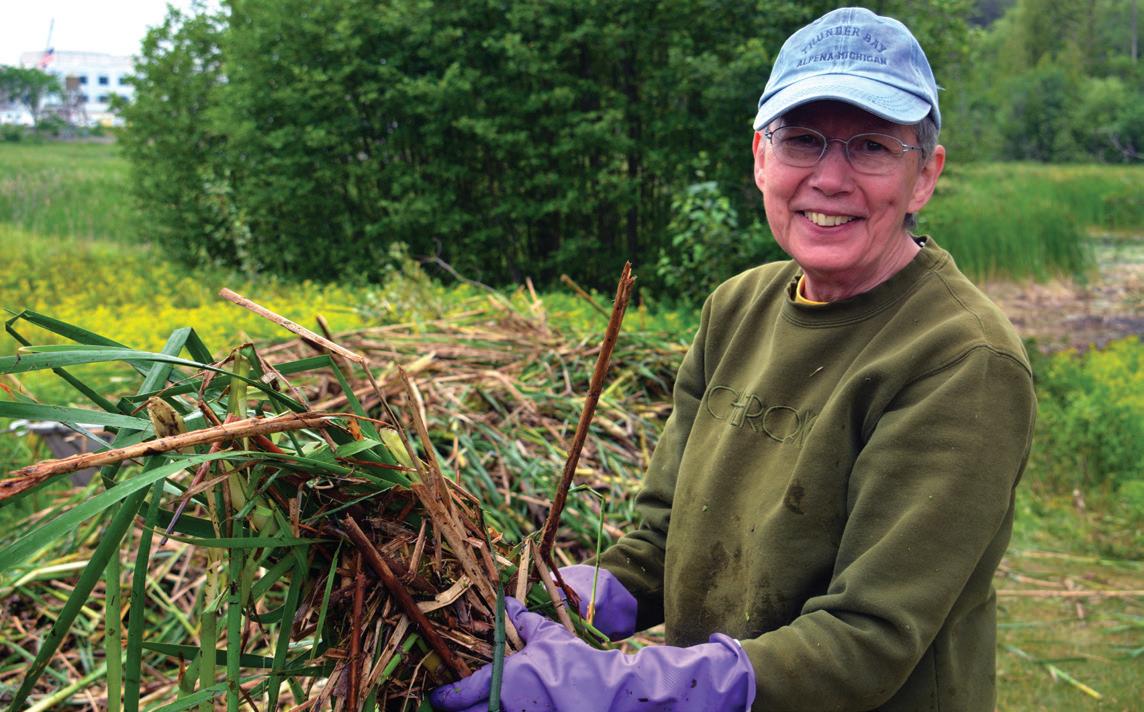
“I have certainly become very wealthy in the friends I’ve made and experiences I’ve had working with our members of Huron Pines AmeriCorps,” she said. “It’s been a great privilege to be involved with Huron Pines and do what little I could in the protection of our land and water, and to encourage our coastal communities to develop an ethic in the conservation of those resources.”
“Judy is an authentic voice for protecting our wonderful natural resources of Northeast Michigan,” said board Chair Greg Bator. “Her enthusiasm and spirit will remain part of our organization going forward.”
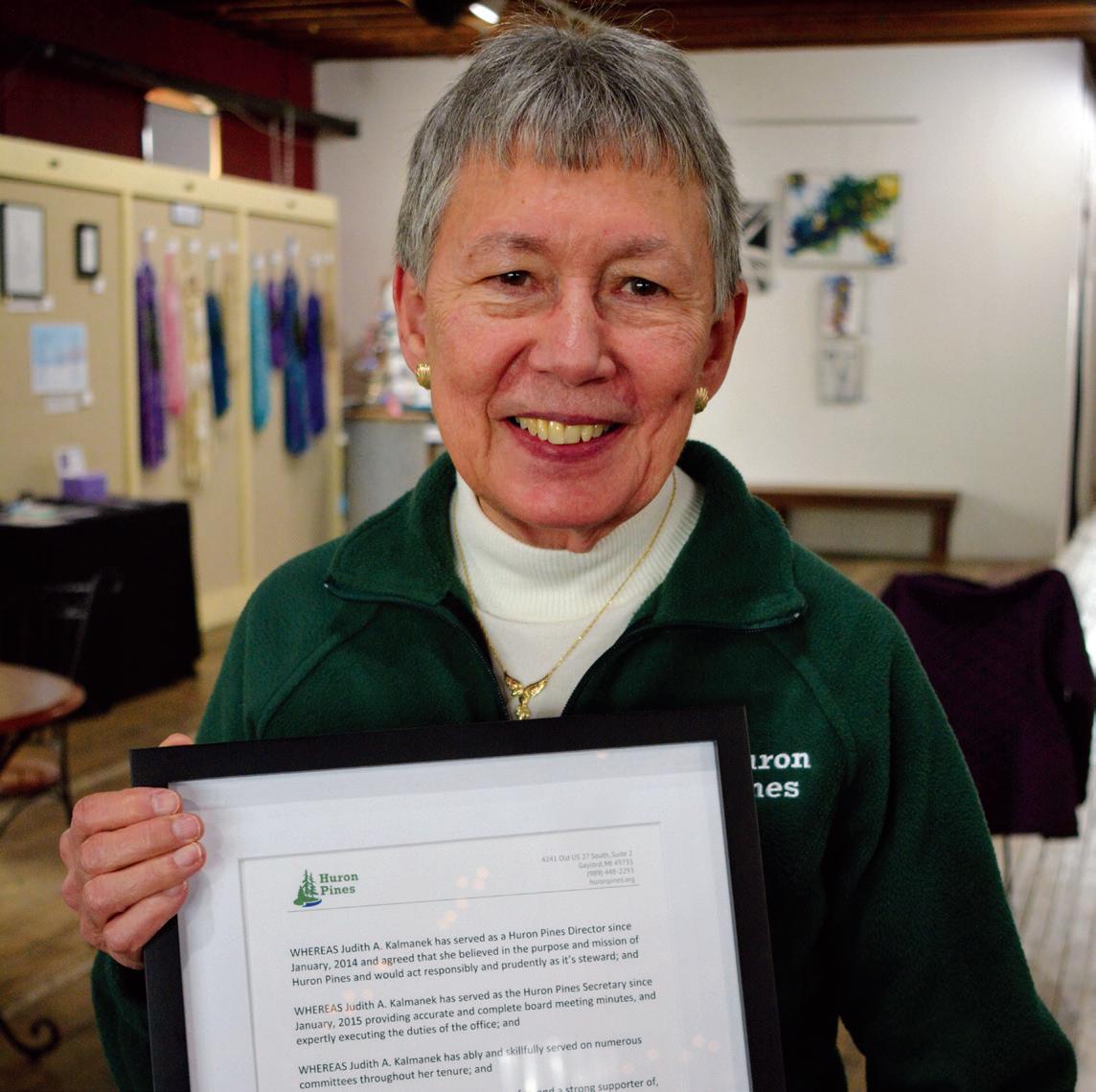
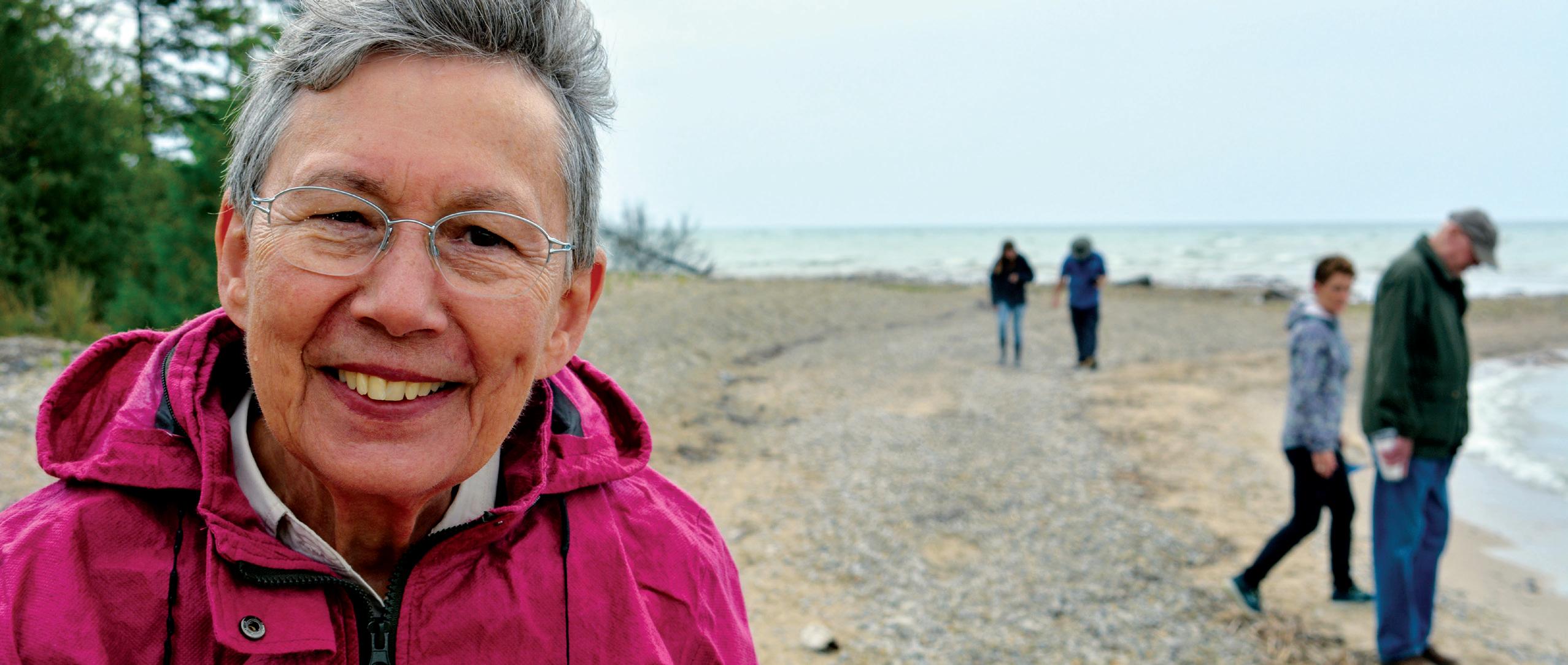
24 | Huron
2022 Annual Report
Pines
“Judy is an authentic voice for protecting our wonderful natural resources of Northeast Michigan. Her enthusiasm and spirit will remain part of our organization going forward.”
A board resolution was presented to Judy Kalmanek in December in recognition of her service.
Judy grips handfuls of cattails during an invasive species removal day at Island Park.
Top: Judy Kalmanek feels a Lake Huron breeze during a board and staff outing at North Point Nature Preserve Aug 1.
2022 Donor List
Thank you to all of our 2022 supporters
Elizabeth Abood-Carroll and David Carroll
Acorn Family Retreats
Christopher Adamo
The Adamo Family
Ruth Addis and Marj Schloff
Albanese Family Fund at Fidelity Charitable
The Americana Foundation
Regina Amidon/Richard Bryan Charitable Fund at Bank of America Charitable Gift Fund
Bill and Debi Anderson
Kirk and Carol Anderson
Lori and David Anderson
Robert Andrus
Ann Arbor Trout Unlimited
Anonymous (12)
The Cathy and Bob Anthony Fund at the Community Foundation for Southeast Michigan as suggested by Mr. and Mrs. Robert L. Anthony IV
Caryl and Russ Anton
Avery Lake Property Owners Association
B2 Great Lakes LLC
Richard and Marilyn Bachelor
Martin and Michelle Baker
George Barker
Al Bartow
Bay Area Community Foundation
Leanora Bender
Bennethum’s Northern Inn Restaurant
Betty Bennett
Besser Foundation
Big Bear Lake Association
David and Elaine Billmire
Mary and Timothy Blackwood
Donald and Gail Block
Kathleen and David Boyd
Richard and Marie Bracci
Bradford Lakes Association
Nathaniel and Lisa Bradley
Carol Brand
Norm and Valerie Brecheisen
Douglas and Kathryn Brehm
Christopher Brierley
Carl Buchner
Gerald and Rose Burke Donor Advised Fund at Schwab Charitable
Jim and Gina Burke
Don Burkley
Al, Pat and Doug Cambridge
Tom and Marcia Cardelli
The Carls Foundation
Brian and Janet Carson
Richard Castle
David Catalan
Anne and John Cauley
Ned Caveney
Cedars for the Au Sable
George and Pamela Charney
Cheboygan Brewing Company
Colby and Tim Chilcote
Michael A. and Sandra S. Clark
Community Foundation for Northeast Michigan
Community Foundation Grey Bruce
Pam and Tom Conquest
The Conservation Fund
Brian and Erin Considine
Consumers Energy
Consumers Energy Foundation
The Anna Owens and Tom Cook Charitable Fund of the Bank of America Charitable Gift Fund
Jill Cooper
Susan Beede & Jay Copeland Fund at Renaissance Charitable
Frank and Kathy Cordray
Corporation for National and Community Service
Robert and Judy Cosgriff
County of Otsego
Bob and Gay Courtois
Mary M. Cox
Ann and Richard Craig
Kathy Crawford
Norma Crouch
Michael and Terri Cwik
Anne and Daniel Danosky
William A. and Linda Demmer
Diane Dennis
William R. and Mary Elizabeth Derwin
Janiene DeVinney
Patrice DeVinney
Nancy Dextrom
Cynthia Dodick
Michael and Darcy Dombrowski
Antonio and Teresa Dorta
DTE Foundation Fund for Regional Manager Strategic Philanthropic Organization Initiatives at Community Foundation of Southeast Michigan.
Katherine Duffy
Sandelands-Dutton Charitable Giving Fund at Fidelity Charitable
John Edwards
John Emmendorfer Jr.
James Engle
Rick and Sharon Engstrom
The Fred A. and Barbara M. Erb Family Foundation
Roger and Dagmar Eriksson
The Chip and Betsy Erwin Family
Erwin/VanKoughnett Family Fund at the Chicago Community Foundation
Evil Queen
Dale and Norma Ewart
Larry and Pat Farris
Ruth Favro
Larry and Vickie Fields
Michael and Cathryn Fields
Barbara and Eugene Fleming
Robert Flickinger
Christopher and Laura Fluke
Flygirls of Michigan, Inc.
Mike and Maureen Foresman
Sharon Fortner
Jim and Sue Francis
Susan Freel
Steve and Corrine Family Fund at Fidelity Charitable
Belinda Friis
John and Wendy Frye
Paul Gambka
T. Eduardo and Maria Garcia
Carol and James Garlo
Jim and Judy Gaskell
Meaghan Gass
Elizabeth Gauthier-Rabaut and Gerald Gauthier
GE Foundation
Noelle George
Peggy Gilbert
Robert Gillenwater
Jacquelyn Girard
William Glass
Leo Goddeyne
Ruth and David Golm
Rusty and Elizabeth Gowland
Robert and Jennifer Grace
Chris and Elaine Graham
Mike and Christine Grant
Jim and Shirley Graves
Great Lakes Fishery Trust
Great Lakes Restoration Initiative
Tom and Joann Green
Jim and Linda Gregart
Ken and Elizabeth Gribble
Jon Griffin
Pamela and Thomas Griffin
Nancy Guregian
Peter and Virginia Gustafson
Beverly and James Haas
Hack Family Foundation, Jan and Talbot Hack, within the Raymond James Charitable Endowment Fund
Rick and Robin Hagopian
Beach Hall
Noah Hall
Michael and Jo Ann Hamm
Dr. Brian and Belinda Hanna
Mary Haws
Blair and Sandra Marie Headrick
Howard E. Hedlund
James and Rebecca Heindl
Jerry Heinrich
Dick and Judy Henry
Kara Herber
Frank and Vicki Herman
Don and Joann Hester
Russ Hicks
Higgins Lake Foundation
Higgins Lake Land Conservancy
Higgins Lake Property Owners Association
Jennifer and Jason Hill
Felicity Hirsh
Margaret Hoerner
Mark Holmen Family Fund at The New York Community Trust
Anne Honhart
Hougen Foundation
William Houston
Stan and Teresa Hubbell
Carl and Vicki Hueter
Heather Huffstutler
Steve Huffstutler
Huron Engineering and Surveying, Inc.
Timothy and Kristine Ianitelli
David Irani and Laurel Moore
Mark Isken
Elizabeth Jacob
Kurt Jagoda
Curt and Susan Jansen
Jansen Family
Joe and Judi Jarecki
Brad Jensen and Rebecca Benson
Sandy Johnson
Marty and Ellen Jones
Elizabeth Juziuk
Judy Kalmanek
Ramzi Khuri
25
Carlynn and Stanley Kidd
George and Linda Killat
Mark Kinney
Chris and Ellen Klebba
Wayne and Marcia Koppa
Jennifer and Michael Koralewski
Mark and Marie Koski
Gary Kovelle
Krenn Timber Bridge, Inc.
Mary K. Krigbaum
Randy Kursinsky
William Kusey
Peggy Kusnerz
Jerry and Susan La Vanture
Julie LaFleche
Lake Horicon Corp.
Bernard and Nancy Lamp
Allan Larsen
David and Joanne Lawless
Kathleen and Duncan Lawrence
Lawrence Lee and Nick Pavelich
Joshua Leisen
The Lewis Family Charitable Fund at National Christian Foundation Michigan
John R. Lindsay
Jenny and Anton Llakmani
David and Julianne Lockwood and Family
Wanda Lord
The Frank W. Lynch and Roberta Jane Lynch
Endowed Family Fund at the Community Foundation for Southeast Michigan as suggested by Ms. Sally L. Binard
Donna and Michael Maddin
Malecki Family Donor Advised Fund at Frankenmuth Community Foundation
Jan Manzella
Kim Margherio
Jack and Julie Marlette
John C. Marsh
John and Nancy Marshall
James Maslanka and Catherine Giebel
Randy and Jeanette Mateer
Laura and Bruce Maxwell
Mayfair Plastics
Samuel and Carolyn McCarter
Michael McDowell
Tim McMannis
Michiganographer
Michigan Community Service Commission
Michigan Department of Environment, Great Lakes, and Energy (EGLE)
Michigan Department of Labor & Economic Opportunity
Michigan Department of Military and Veterans Affairs
Michigan Department of Natural Resources
Michigan Natural Features Inventory
William D. Middleton
Charles and Linda Mires
Drs. Bruce Hull and Margaret Mitchell
Allen and Jean Moberly
Mike Monroe and Candace Henig-Monroe
Montmorency County Conservation Club
John and Connie Morgan
Morley Foundation
Thomas B. Mudd
Glenn Muhr
Thomas G. and Rosemary Mullaney
Tom Mundt
Sandra Murphy
Lawrence Nanni and Kathryn Frisby
National Fish and Wildlife Foundation
National Oceanic & Atmospheric Administration
National Wildlife Federation
The Nature Conservancy
Ross Nave
David and Nancy Neal
Gary and Tess Nelkie
Patty Neuman
Gary Neumann
News Corp
Les Nixon
Northern Family Dentistry PLLC
Amy Nowakowski
Mary Jo Oke
Janet Opdyke
Oscoda Canoe Rental, Mark and Adam Hume
Mr. and Mrs. William D. Palmer
Michael and Donna Parr
Paul Paske
John Peppler
James Pestka
Keith Petherick
Robert and Mary Lou Petrach
Barbara and Alan Pfau
Don and Sis Pierce
Ben and Kristine Pinti Giving Fund at Fidelity Charitable
Tony and Melanie Pitts
Joseph and Carole Plunkey
Steve Pollack
Bill Posak
Jeff and Tina Precup
John and Martha Pregler
Floyd Prospero and Nancy Krompotich
Tami Pullen
Robert and Jean Radin
Keith Radwanski and Erin Fanning
Lisha and Mark Ramsdell
Robert and Jean Ramseyer
Kurt Ranka
Recreation Fishing Club
Diane and Robert Reeve
Mark Rice
Jack and Phyllis Richards
Theresa Richter
Terri Riopelle
Robertson Family Charitable Gift Fund at Band of America Charitable Gift Fund
Linda Rogers and Vince Lumetta
Roscommon Auto Recyclers, Inc.
Richard Rose
Keith Ross
Katherine Roth
Dr. and Mrs. Nathaniel H. Rowe
Saginaw Bay Watershed Initiative Network
Mary Sanders
Robert and Norma Sanders
Linda and David Sandvik
Neil and Joan Satovsky
Tony and Jill Scarzo
The Gregory Seaman and Heather McNamara
Charitable Fund at Schwab Charitable
Robert and Marcia Seaman
Marcia and Robert Selley
Bill and Denise Semion
Pete and Kimberly Sermo
V. Carl Shaner
Elizabeth, Allan & Warren Shelden Fund
Jacob and Darby Shinners
James Shinners
Louise and Ronald Shoksnyder
Peter Simpson
Edward Skarbek
Pamela and Stephen Skillman
Jerry Smith and Linda Arlt-Smith
Robb and Christine Smith
Stewart and Carol Smith
Harold Sorenson
Ronald H. and Kristin A. Sorgenfrei
Michael and Suzanne Sorrentino
Renee Soultanian
Joey Spano
Robert and Jane Sparks
Bob and Jane Spence
Donette Spiekerman
Barbara Spuhler
Walter Stansbury
Judy and William Stark
Bill and Charity Steere
Sindy Steffner
John Stewart
Daniel and Jeanne Stock
Philip and Janet Straley
Straley Lamp & Kraenzlein PC
Bob and Debi Stuber
Melinda Study
Sundew Environmental, LLC
Sunrise Side Master Gardener Association, Inc.
Fred and Carole Swinehart
Colleen and Norman Tabaka
Andrew C. Tarkington DDS
Robert and Mary Louise Tarkowski
Martin Tatuch
Chuck and Karen Tetzlaff
Stephen and Jamie Tews
Saginaw Bay Watershed Initiative Network (WIN)
Michael Thome
Thunder Bay Audubon Society
Thunder Bay River Center
Tom Trevillian
Jay and Bev Trucks
Molly Tschirhart
Helen Tull
Michael Turisk
U.S. Environmental Protection Agency
U.S. Fish & Wildlife Service
U.S. Forest Service
Kyle Valade
Julie Vanderhoff
Eric VanPoucker and Ronald J. Smith
Verizon Foundation
Michelle Vincent
Peter and Carol Walters
Phillip R. and Nancy A. Walters
Walters Family Foundation
James R Weeks Jr
Michael Wells
Mr. & Mrs. Frederick Wenn
The Wible Family Fund at Fidelity Charitable
Kenneth Wierzbicki
Roderic and Ruth Wiley
Peter and Lynn Wilson
Mary Ann, Edward and Kevin Wojahn
Richard Wolff
Stanley and Linda Yolkiewicz
Jennie and Mike Zoll
26 | Huron Pines 2022 Annual Report
In Honor Of
Gifts made in honor of the names in bold
Andy Agren
From The Lewis Family Charitable Fund at the National Christian Foundation Eastern Michigan as recommended by Michael and Kathryn Lewis
Eric Bankhead
From Shannon Bankhead
Ciara and Skyler
From Sandra Schmidt
Dottie
From Chris and Chelsea Engle
The Erickson Family of Alabaster
From Gary and Ruth Barnes
Chip and Betsy Erwin and Family
From the Richard E. and Dixie L. Erwin Family Fund at The Chicago Community Foundation
In Memory Of
Gifts made in honor of the names in bold
Dolores T. Bator
From Carl and Sue Simcox
Dolores & Chester Bator
From Gregory and Cecilia Bator
Dr. Ronald J. Beatty and Paul V. Beatty
From Valerie Beatty
Bing and Bonnie Benghauser
From Karl Benghauser
Larry Bilby
From Ralph and Nancy Rucinski
Christopher S. Bollin
From Peg Cowdin
From Doug and Karen Kunka
From Robert Kuznia
From Cynthia Novak
Jack & Jean Clements
From Fred and Diane Alati
William & Violet Clements
From Fred and Diane Alati
Aaron Eliot Cohen
From Dr. Lynn S. Cohen and Stephen B. Cohen
Kyle John Cummins
From Michael Thome
Herbert Deckett
From William Deckett
David Dickinson
From Anonymous
Martin Dolley
From Gail and Randy VanVels
Steven B. Duby
From Laura Duby
G. Sandy Duffy of Tawas Beach Club
From Barb and Charlie Lawrence
George “Sandy” Duffy
From Mary and Daniel Kelly
From Christina Smith
From Peter and Chiara Barbier
From Martha and Kurt Neumann
Bea Engle
From Chris and Chelsea Engle
Dr. David A. Feighan
From Mrs. Pat Feighan
Carlos Fetterolf
From Mark Delaney
Roger Frye
From John and Wendy Frye
Kathy Erwin, Dirk VanKoughnett and Family
From the Richard E. and Dixie L. Erwin Family Fund at The Chicago Community Foundation
Amber Hubbard
From Janet and Jerry Stange
Rachel Leggett
From Ruth Peek
My grandchildren
From Patricia and Mark Watkins
Bob Thompson
From Red Hat
From Kate Thompson
Keith & Pennie Vogelheim
From Emily and Brian Vogelheim
Lake Huron Coastal Preserve
Donors to the Lake Huron Coastal Preserve project in 2021
Jeffrey A. and Christine P. Baker donor advised fund at Schwab Charitable
Jill Cooper
Carol and James Garlo
James Pestka
In Honor of Nikander/Nicander Family
From Arthur Nicander
Tina Foster
From Scott Foster
Violet & Lynne Gonzales
From Harold Sorenson
James and Goan Graw
From Dave and Donna Tinsley
From GM Giving
Celeste Jensen
From Jerry Jensen
Nels Johnson
From Diane and Glen Matthews
Maha and Suhail Khuri
From Ramzi Khuri
Norbert & Caroline Koschmann
From Donald and Gail Block
Vic and Alice Maddox
From Thoralf and Victoria Hoelzer-Maddox
Sue Maxwell
From Cathy’s Hallmark
Donald McMannis
From Tim McMannis
Mary & Rick Moreau
From Richard Moreau
Charles and Elizabeth Moshier
From Jon and Elizabeth Moshier
Jerry Myers
From Glen and Gwen Catt
William Myers From Sharon Myers
Edward Zachary Ryder
From Richard and Penelope Crawford
Connie Schrieber
From Ann Agens
From Donna Andrew
From Eric Bankhead
From Mark Bankhead
From Shannon Bankhead
From Gary and Marcia Boyd
From Sally Brand
From Ugis and JoAnn Bruveris
From John and Jane Dallas
From William and Patricia Duncanson
From Glen and Martha Eberly
From Sandra Gibson
From Egelhofer, Richard and Kathleen Gies
From Terry and Ruth Ann Hoiles
From Mike and Sue Inman
From Brad Jensen and Rebecca Benson
From Steve and Sue Jessup
From Shirley Johnson
From Darby Kuenzel
From Jerry and Susan La Vanture
From Heather and Dave Lovell
From Mary Anne Marx
From Susan McCloskey
From Greg and Diana McComas
From Thomas and Marcella McKinney
From Jerry and Janet Petersen
From Lisha and Mark Ramsdell
From Ric and Dena Rentfro
From Ann and Steven Rhodes
From George and Jeanette Roe
From Jerry and Fran Rucker
From Tony and Jill Scarzo
From George Shaw and Bonnie Marsh
From Jackie Sheridan
From Sue and Jim Shiflett
From David Smith and Marie Harrington
From David Smith
From Craig and Pat Squire
From Vern Steffel Jr. and Cynthia Steffel
From Cynthia Vaccarelli
From Emily Vogelgesang
From W.K. Kellogg Foundation
From Larry and Marjorie Warner
From Clare Wick
Michael Sefton
From Dave and Lynn VanderLinde
JoAnn Smith
From Roger and Mary Fechner
Richard & Lucille Swinehart
From Swinehart LLC
Bud Slingerland
From Paul and Carol Rose
Dick Walle
From Judy Walle
Marian K Ward
From Carolyn Jean Braden
Dr. Stephen Edward Werner
From T. Eduardo and Maria Garcia
Everett “Bud” Woods
From Patricia Woods
27
In Memoriam: Roger Frye & Connie Schreiber
Roger Frye
Long time board member Roger Frye passed away July 27th.
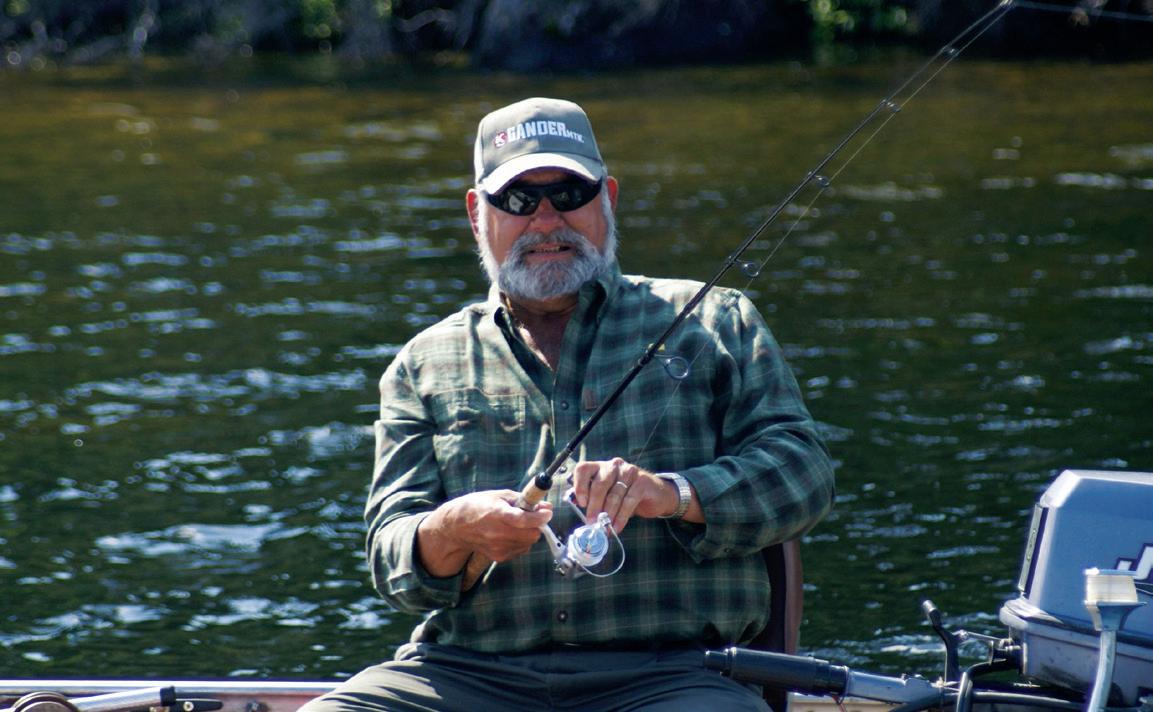
As our Vice Chair for 18 years, Roger helped the organization transition from its more quasi-governmental roots to a not-for-profit organization in the 90’s and early 2000’s. Roger’s background, experience and varied interests were critical to the growth of Huron Pines during that transformative time. When he wasn’t off on a hunting or fishing trip, he was telling stories about his adventures. A true outdoorsman, Roger served his community on many boards, including 20 years as a Montmorency County Commissioner. Roger’s background, experience and varied interests were critical to the growth of Huron Pines during that transformative time.
Roger owned a business in the forest products industry. His professional experience provided Huron Pines with a unique perspective on balancing conservation with the utilization of natural resources. He understood and helped guide our work to support a strong natural resource economy while maintaining healthy resources.
Roger’s son John and daughter-in-law Wendy would eventually go on to become our first nature preserve donors, establishing the Hubbard Lake Nature Preserve in 2018, where the entire Frye family made many fond memories.
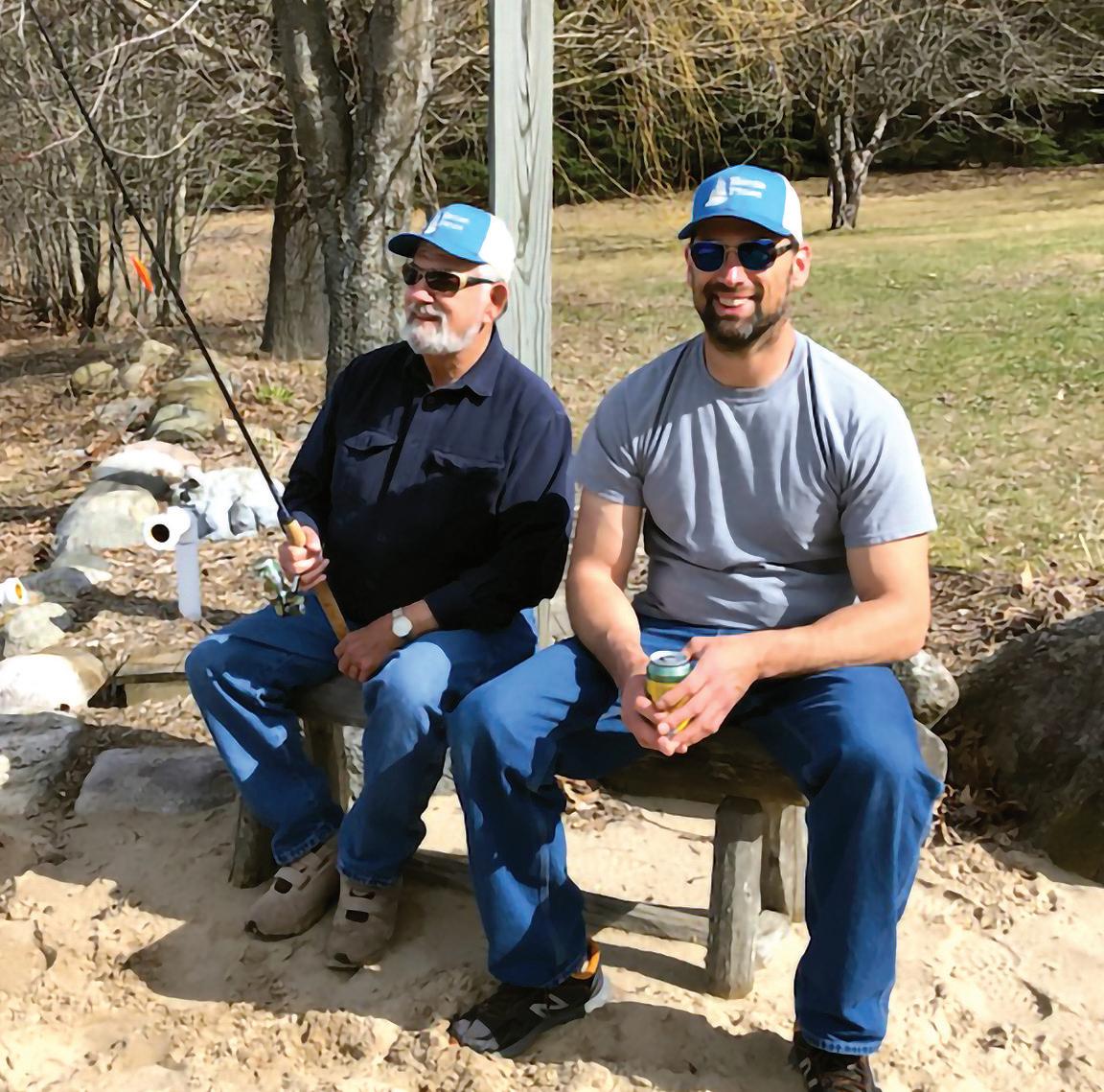
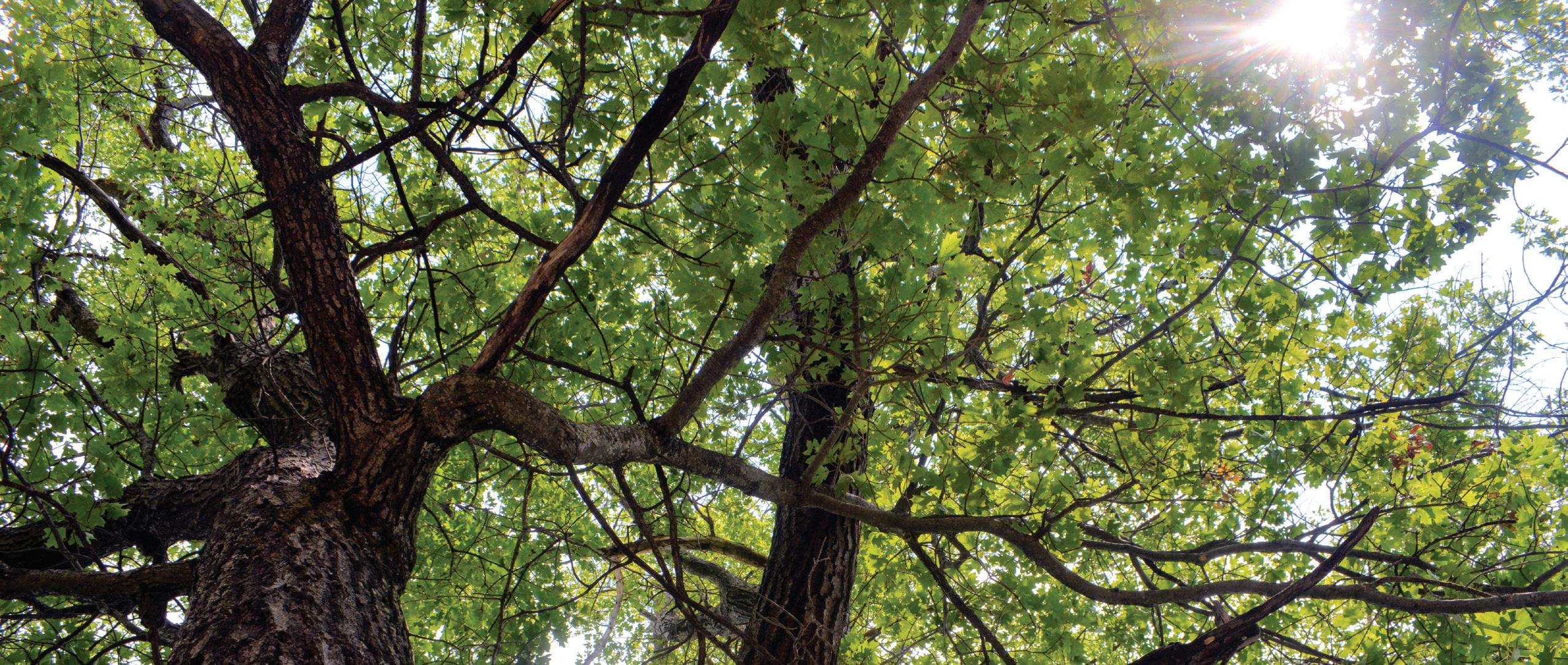
28 | Huron Pines 2022 Annual Report
“As our Vice Chair for 18 years, Roger helped the organization transition from its more quasi-governmental roots to a not-for-profit corporation in the ‘90s and early 2000s.”
Roger enjoying the day with his son, John Frye.
Roger enjoys a day on the water. Fishing was one of his greatest passions.
Connie Schrieber
We lost a dear friend, dedicated volunteer and longtime champion of Huron Pines with the March 3rd passing of former board chair Connie Schrieber.
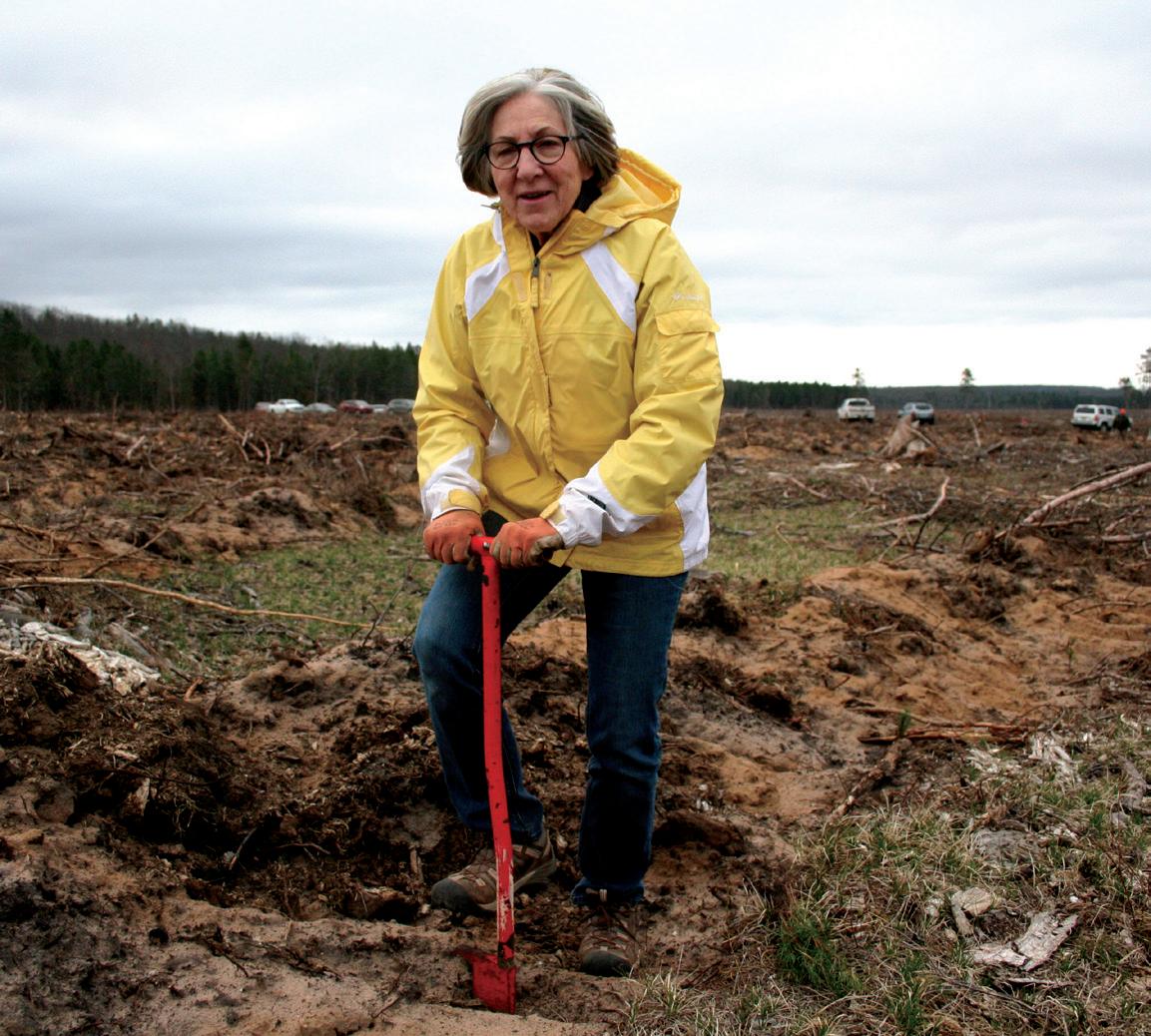
Connie stepped down from our Board of Directors in 2019 after almost 14 years of service, including six as chair. Our organization experienced significant growth in its programs during her time with us, due largely to her encouragement to tackle Northern Michigan’s environmental challenges with new and innovative approaches.
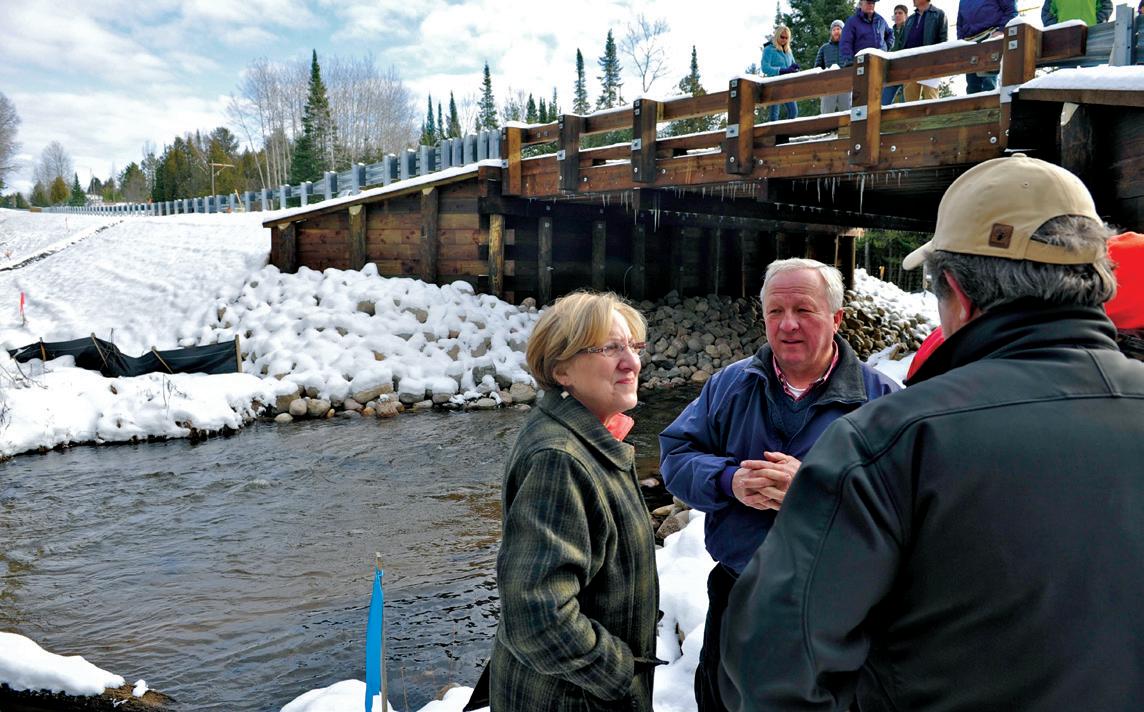
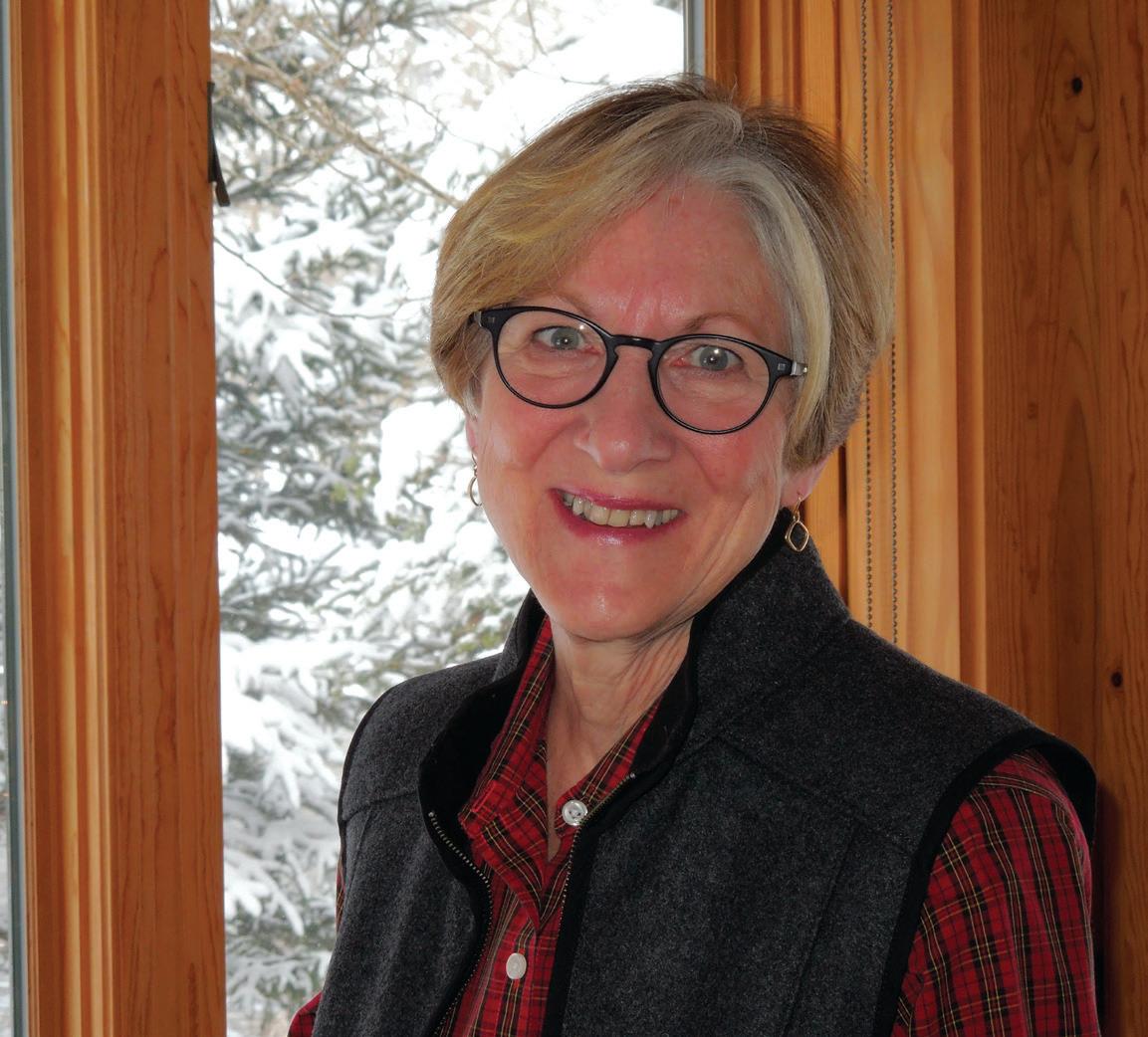
A line in Connie’s obituary encapsulated her character and charm.
“Some words to describe Connie are ‘determined, vibrant, quick witted, dynamic and very entertaining,’” read the tribute. “If you met her, you liked her. If you knew her, you loved her.”
She was a familiar face at Huron Pines’ public events, and immersed herself in field work by volunteering to hand-swipe phragmites during invasive plant treatments or donning waders and dipping a net to survey streams for aquatic insects. Just as important, Connie spoke proudly of our organization in communicating our mission to conserve and enhance Northern Michigan’s natural resources for healthy water, protected places and vibrant communities.
In honor of Connie’s entrepreneurial spirit, the board established the Connie Schrieber Fund for Environmental Innovation in 2019 to support development of new initiatives to address Northern Michigan’s emerging environmental needs. The fund will foster continued innovation, in Connie’s name, that will enhance and protect Northern Michigan’s woods, waters and communities.
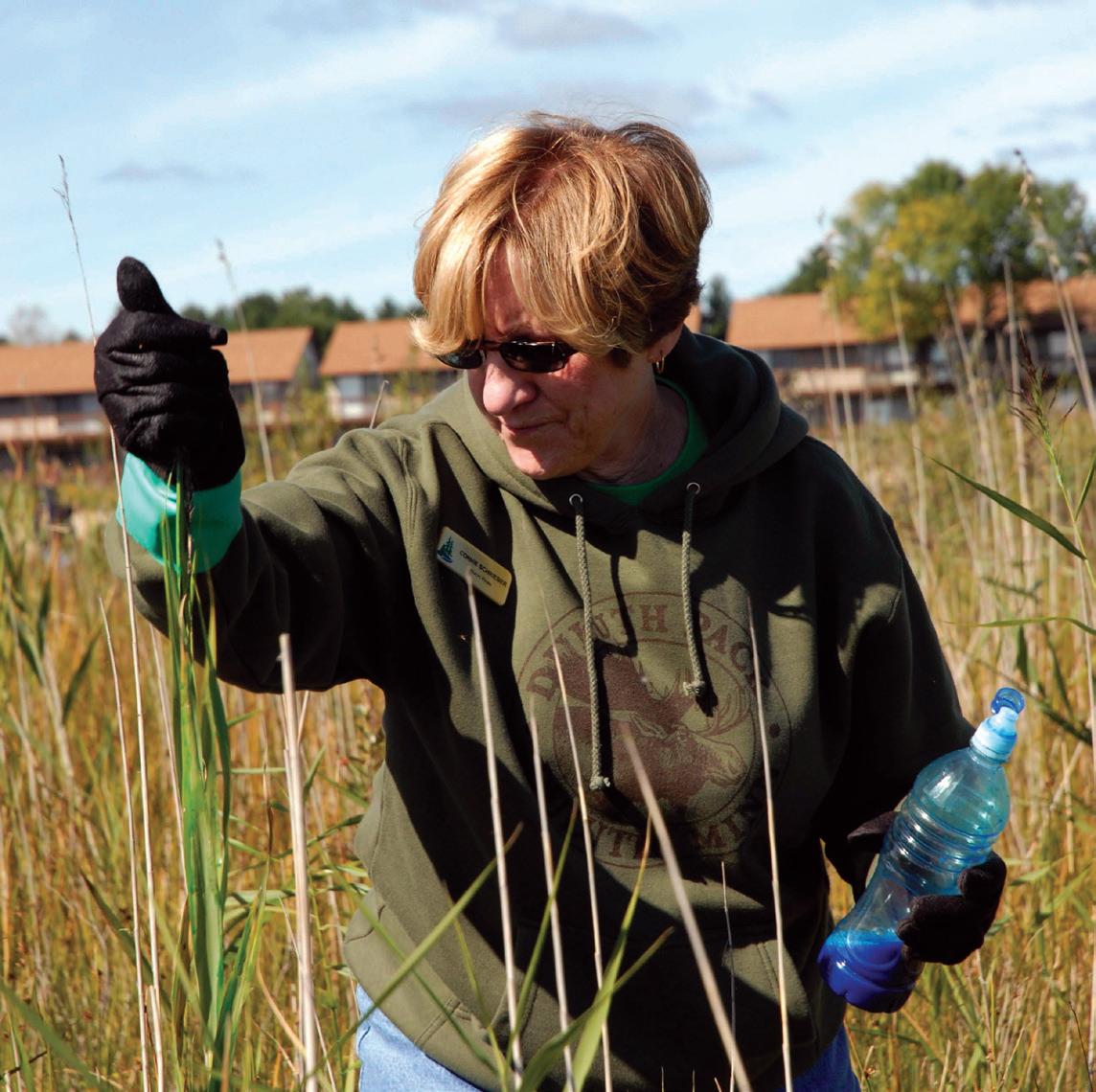
“Some words to describe Connie are ‘determined, vibrant, quick witted, dynamic and very entertaining.’
If you met her, you liked her.
If you knew her, you loved her.”
A regular volunteer at our stewardship events, Connie hand-swipes herbicide onto invasive phragmites in 2010 in Iosco County.
Connie plants jack pine seedlings for Kirtland’s warbler habitat in 2016.
In Memoriam | 29
Connie chats with partners at the 2012 ribbon cutting of a timber bridge over the Sturgeon River at Poquette Road.

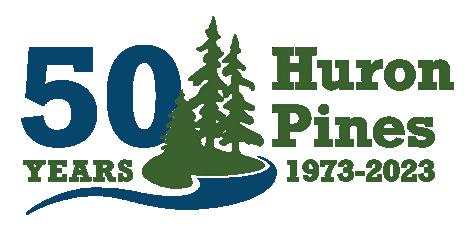
Show your support for the people, prairies, woods, waters and wildlife that make Northern Michigan special. O rder your limited-edition Huron Pines 50th anniversary gear today. Proceeds will help support the work we do to conserve and enhance Northern Michigan’s natural resources to ensure healthy water, protected places and vibrant communities. CONNECT WITH US HURONPINES.ORG To browse all of the products available visit huronpines.itemorder.com/shop 4241 Old US 27 South, Suite 2 Gaylord, MI 49735 (989) 448-2293 huronpines.org Non-Profit Org. U.S. Postage Paid Petoskey, MI Permit No. 110
















 Raising the sign at Hubbard Lake Nature Preserve in 2018
Alcona students install native plants at the preserve in 2021
Dwarf lake iris, Michigan’s state wildflower, at North Point Peninsula
An aerial view of Birdsong Bay Nature Preserve
Raising the sign at Hubbard Lake Nature Preserve in 2018
Alcona students install native plants at the preserve in 2021
Dwarf lake iris, Michigan’s state wildflower, at North Point Peninsula
An aerial view of Birdsong Bay Nature Preserve











 Restoration site in summer 2022
Restoration site in summer 2022















 Senior Project Manager Josh Leisen inspects the silt separator in 2022.
Staff, partners and residents celebrate the silt separator with a ribbon cutting in 2014.
Volunteers Zeke Hill & Chris Preston install plants near Tawas State Dock.
Land Protection Coordinator Julia Butch — then a member of Huron Pines AmeriCorps — carries a flat of plugs to be planted near Tawas State Dock.
Senior Project Manager Josh Leisen inspects the silt separator in 2022.
Staff, partners and residents celebrate the silt separator with a ribbon cutting in 2014.
Volunteers Zeke Hill & Chris Preston install plants near Tawas State Dock.
Land Protection Coordinator Julia Butch — then a member of Huron Pines AmeriCorps — carries a flat of plugs to be planted near Tawas State Dock.











 2007 members mark the completion of a 10-month service term with an end-of-year celebration.
2007 members mark the completion of a 10-month service term with an end-of-year celebration.


















